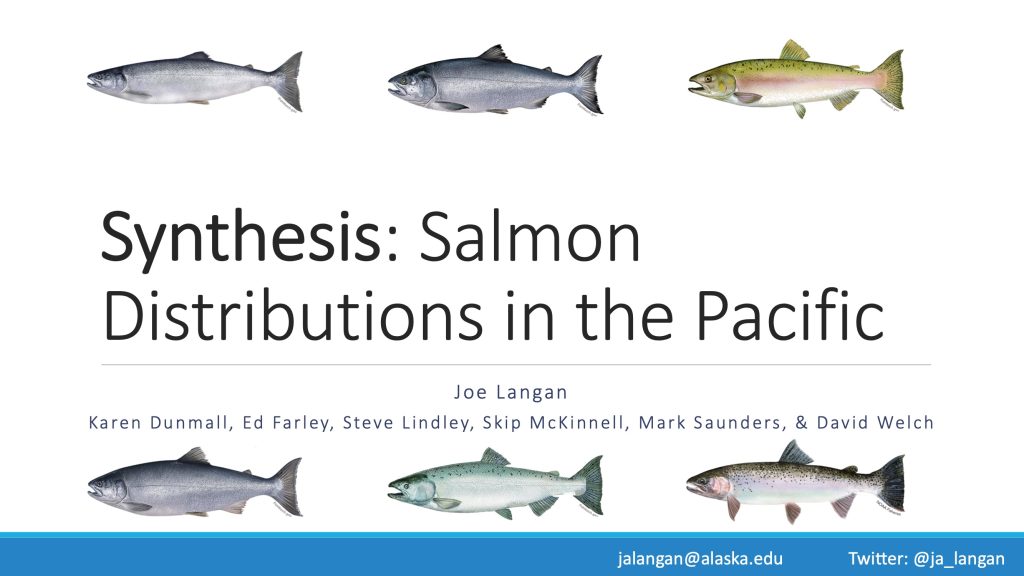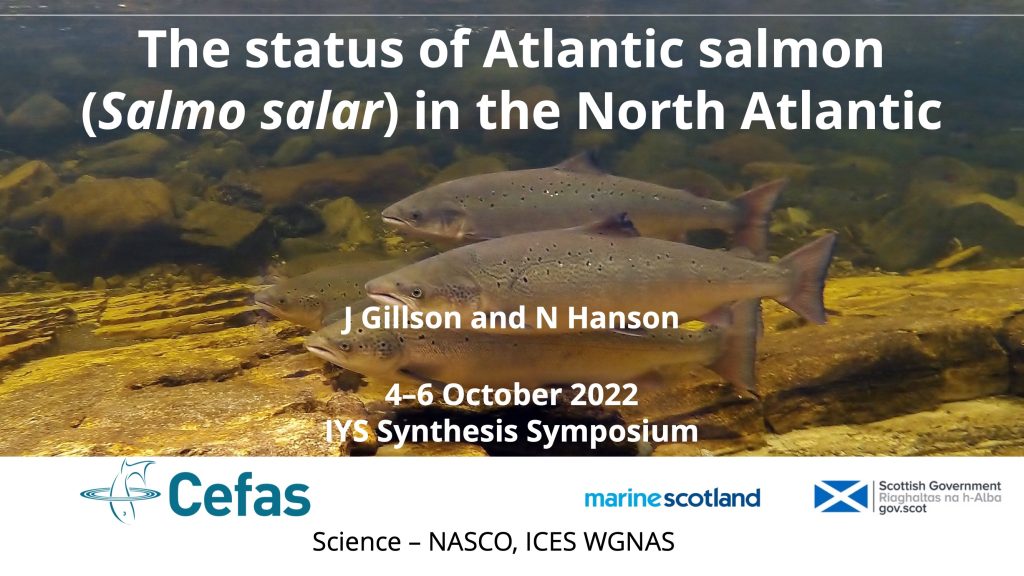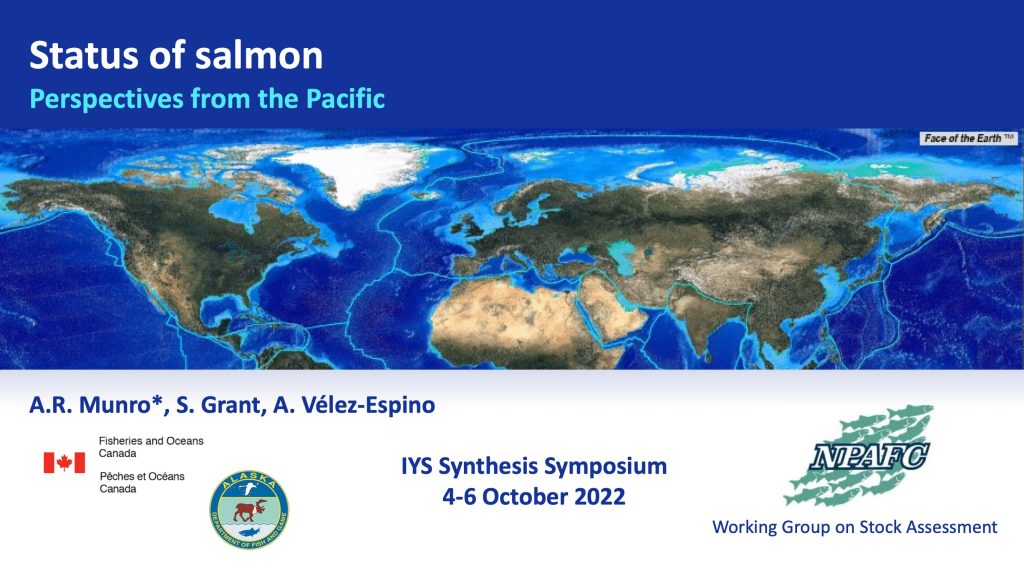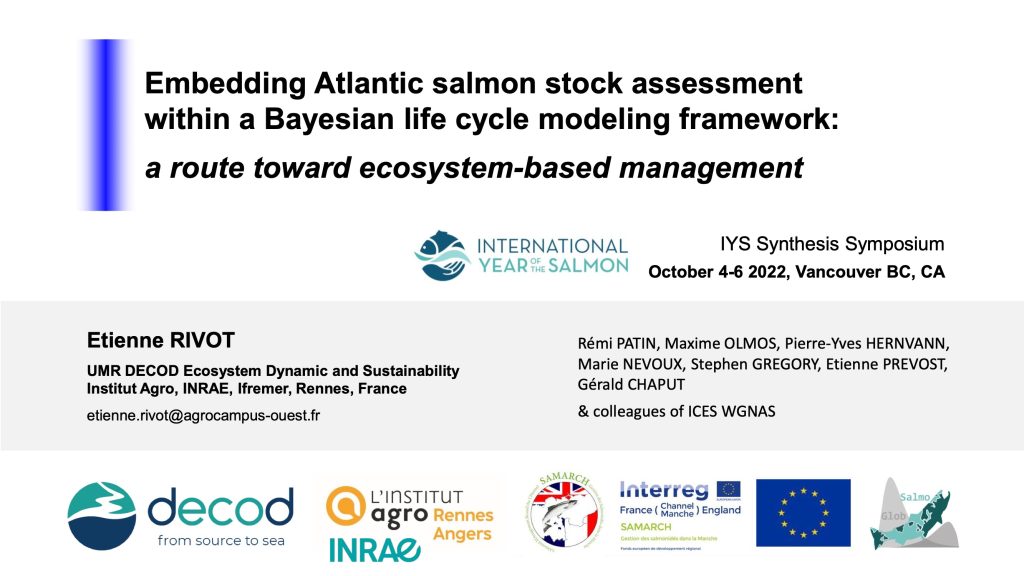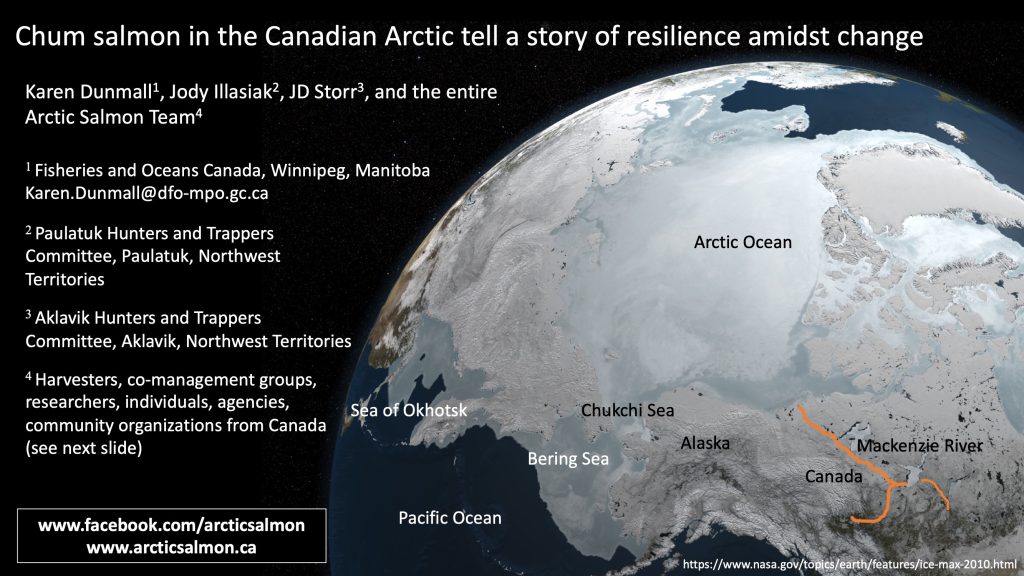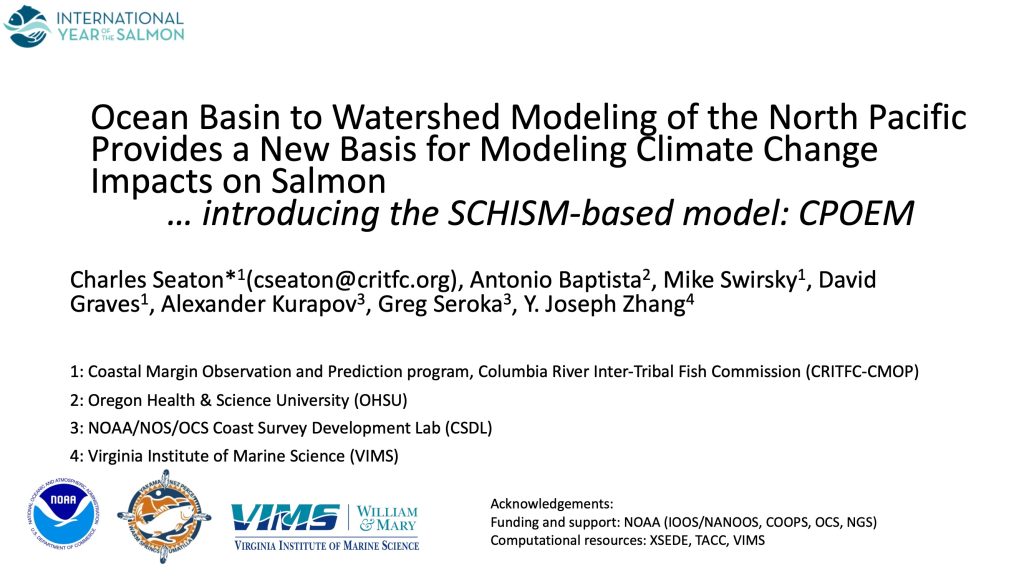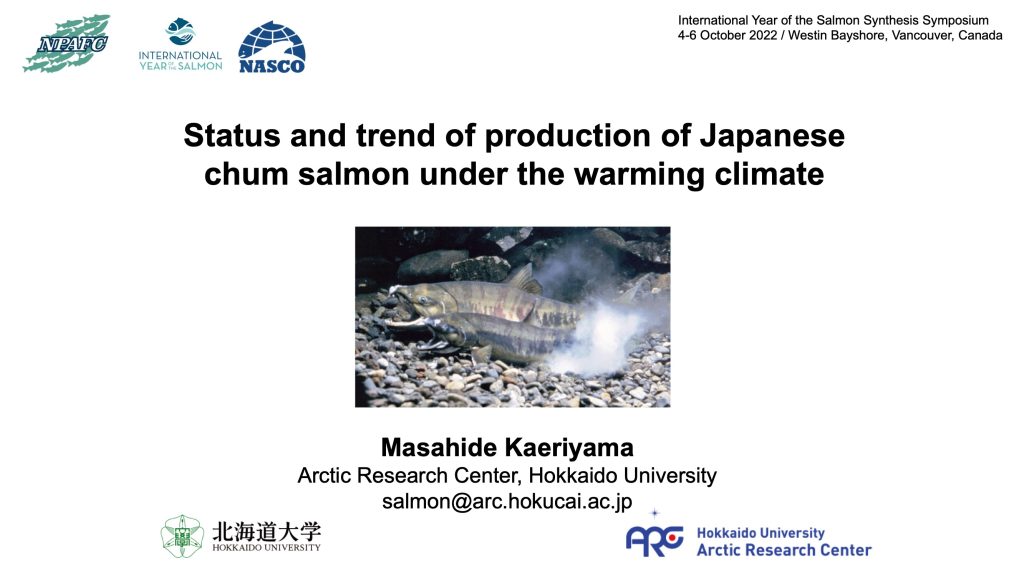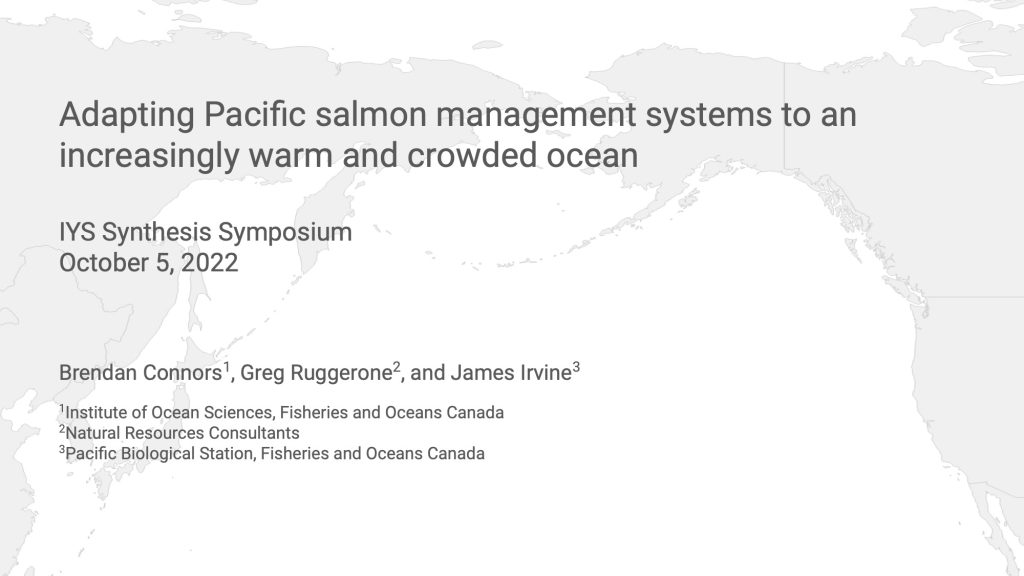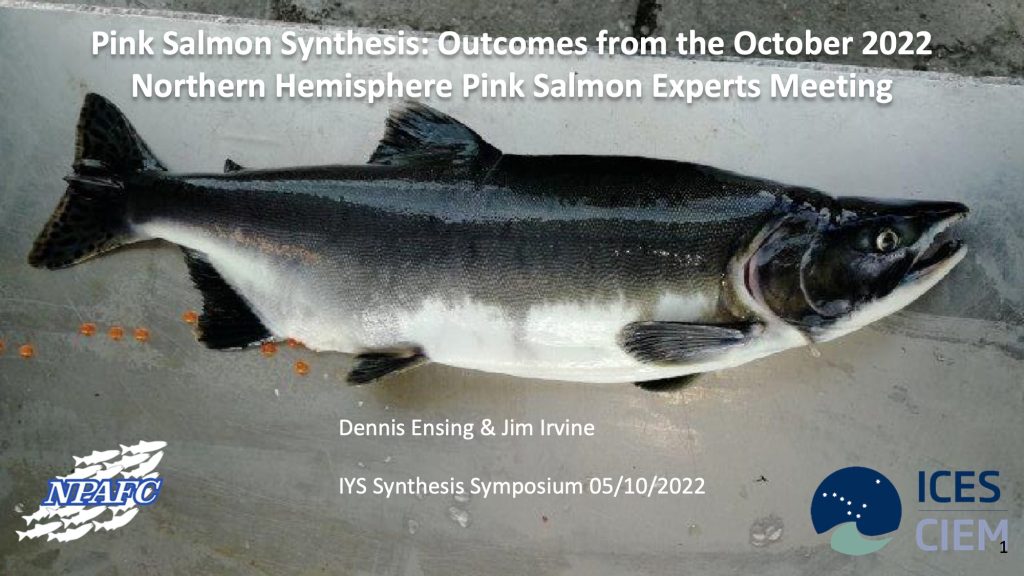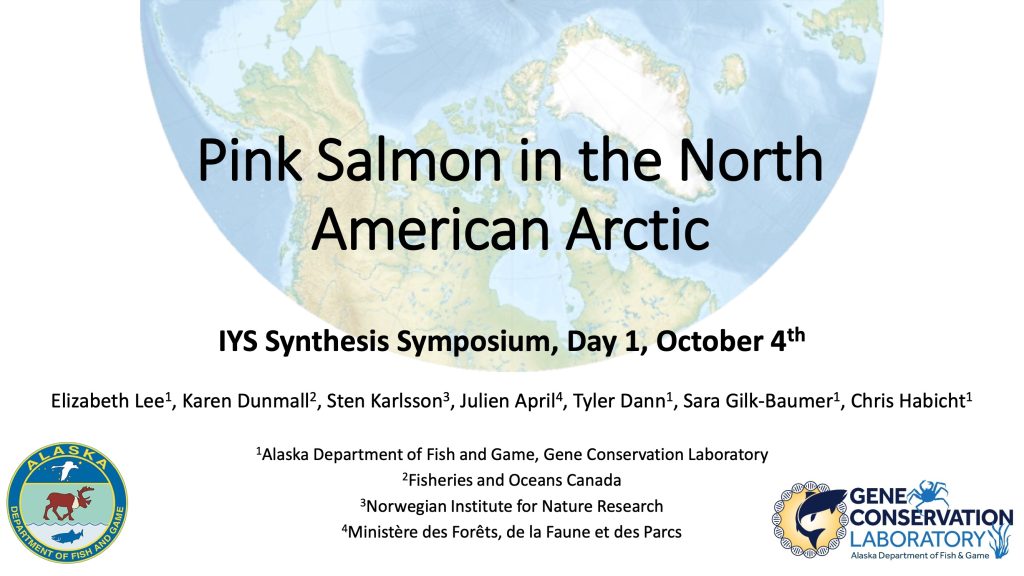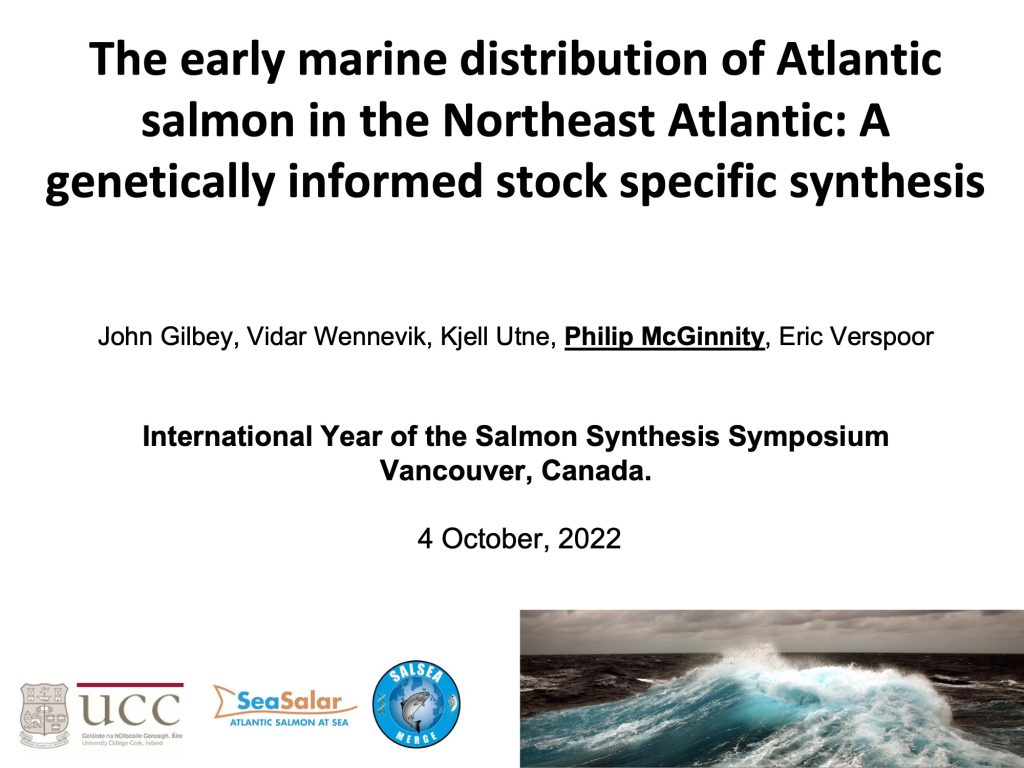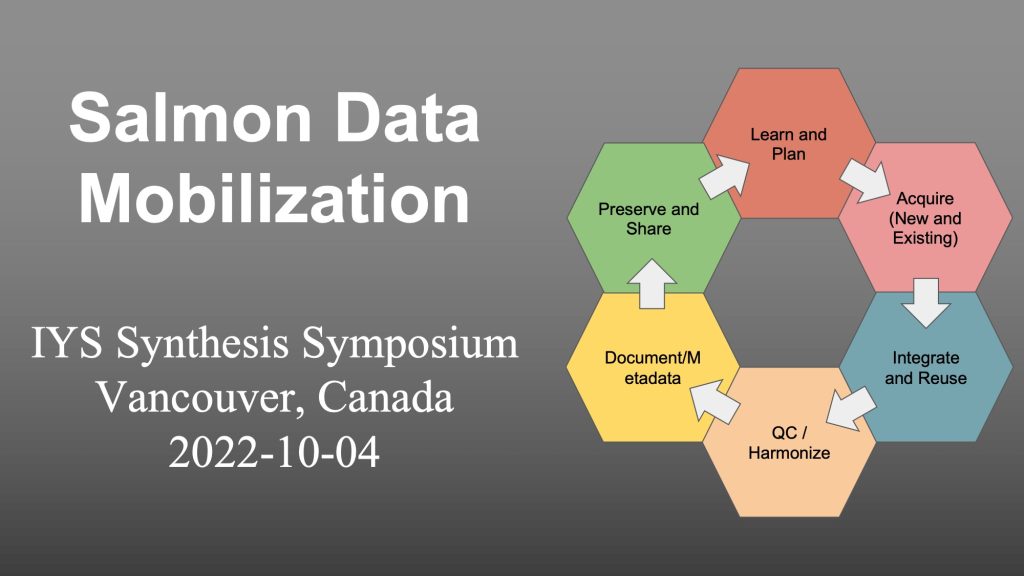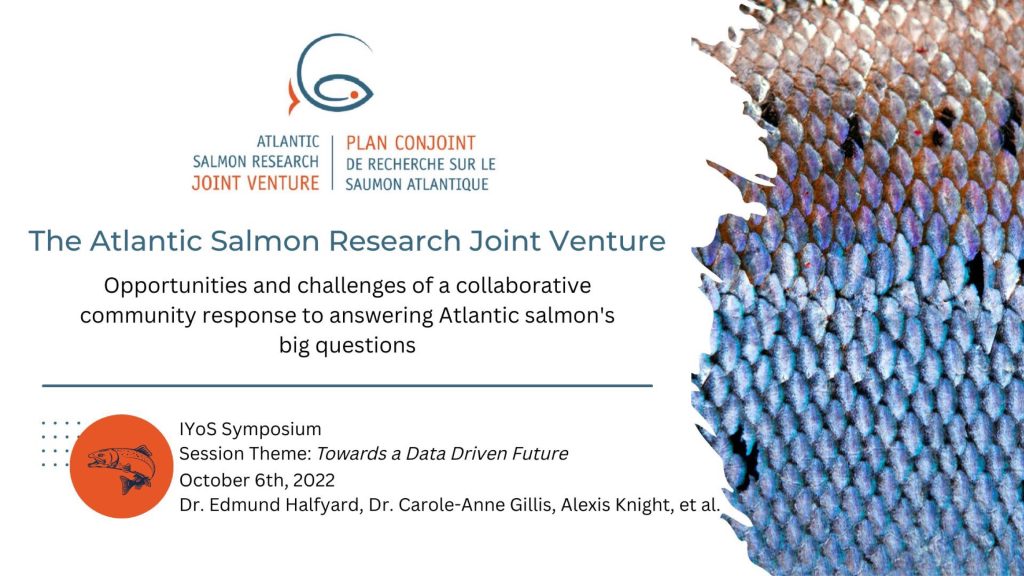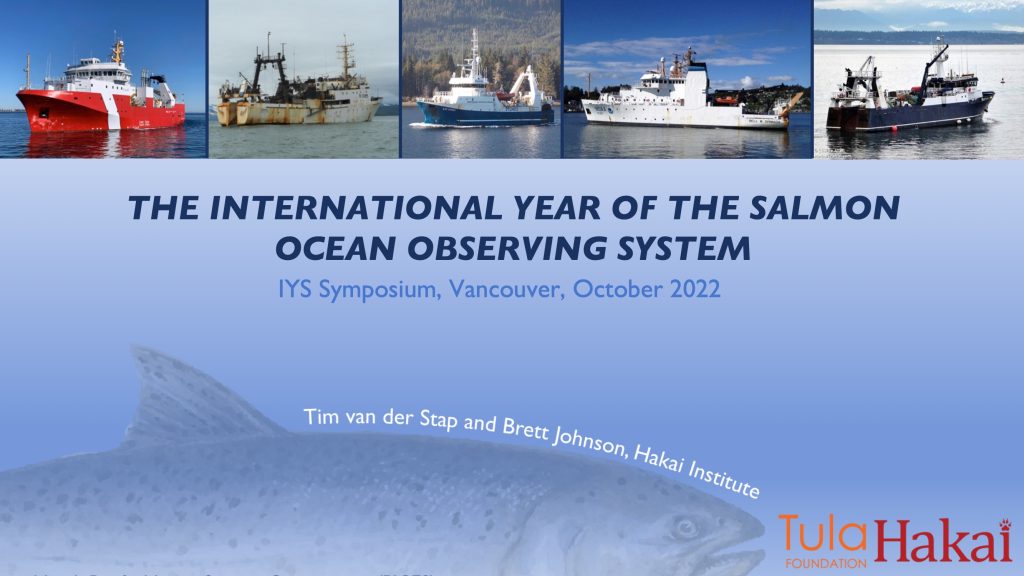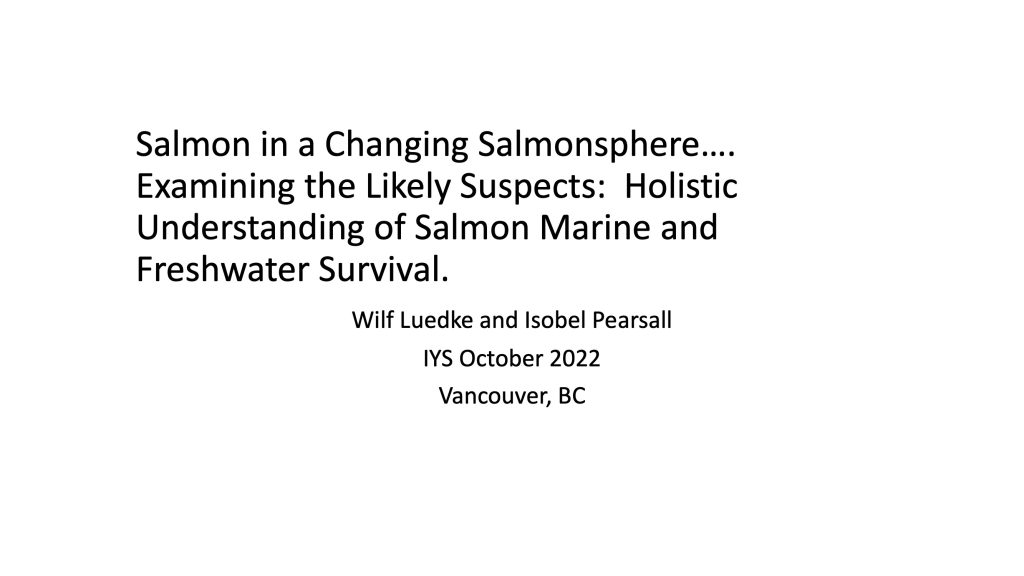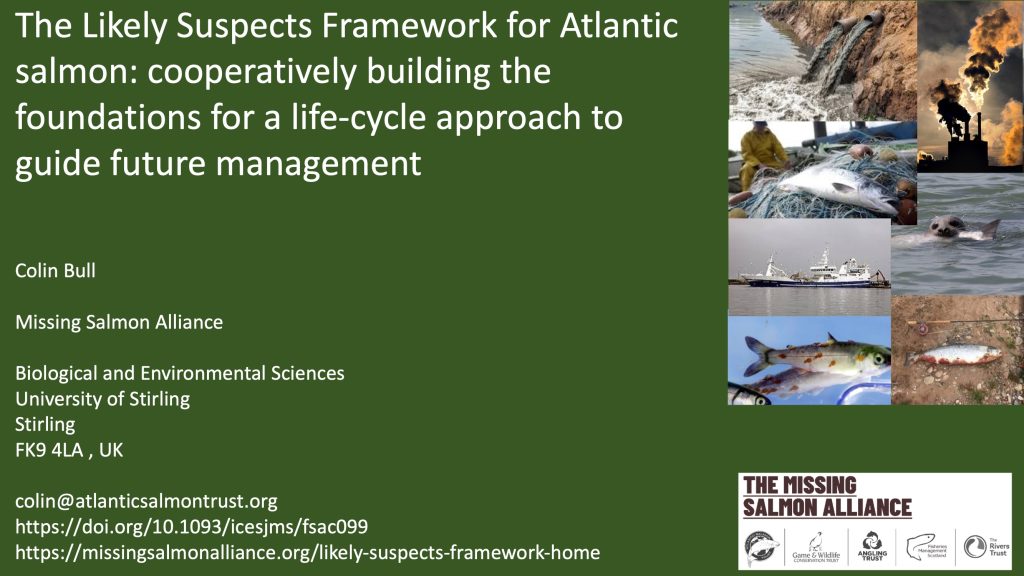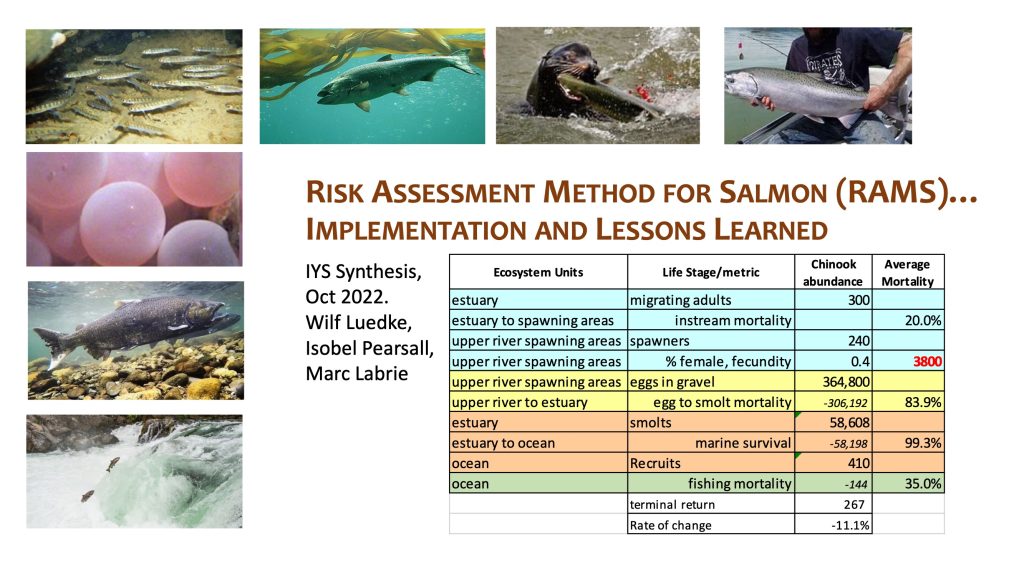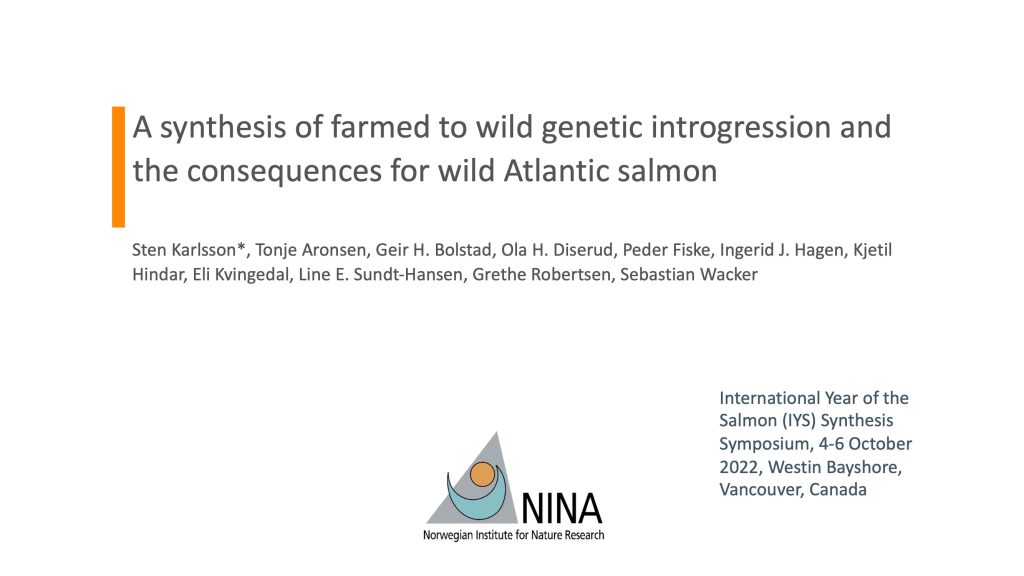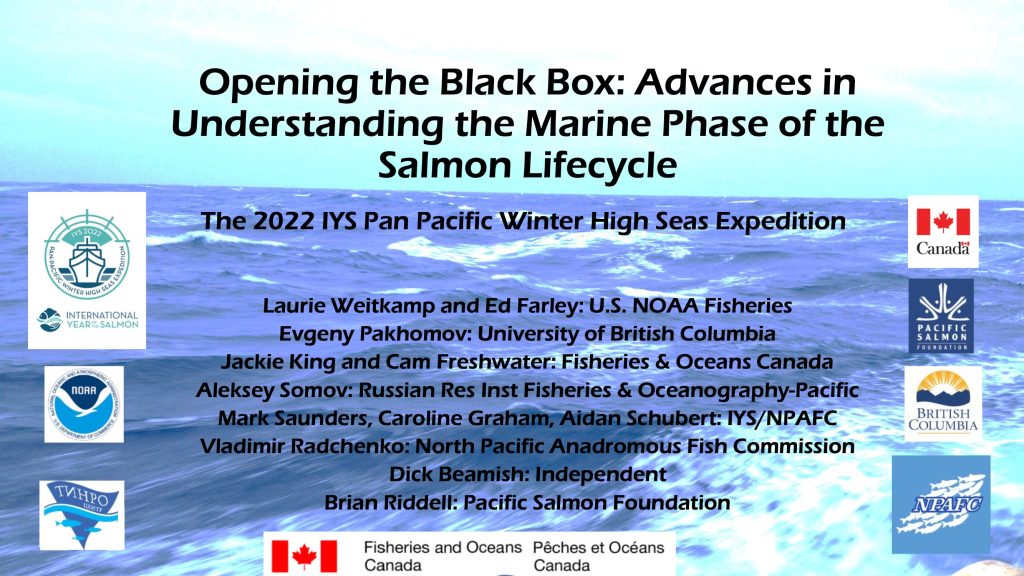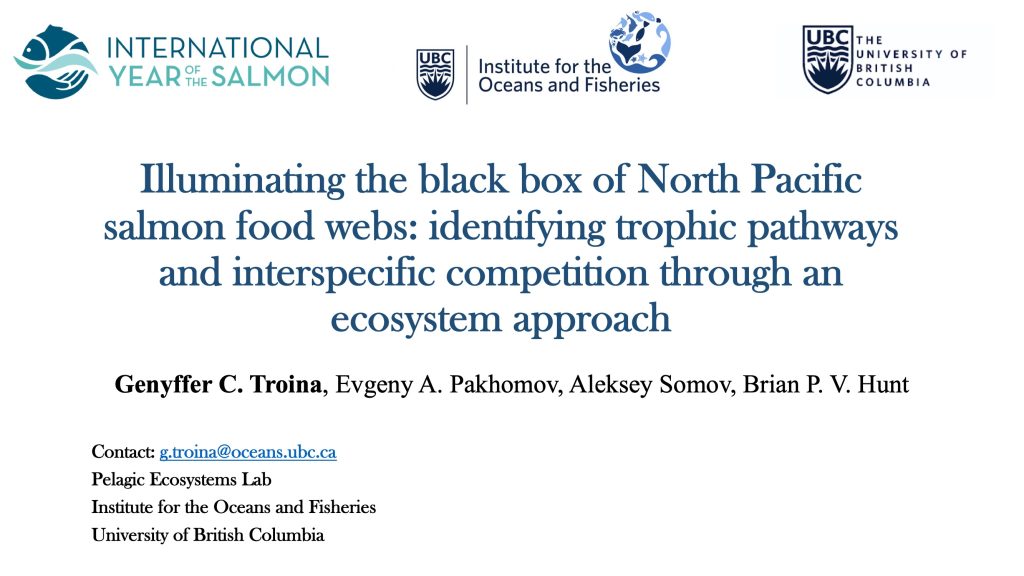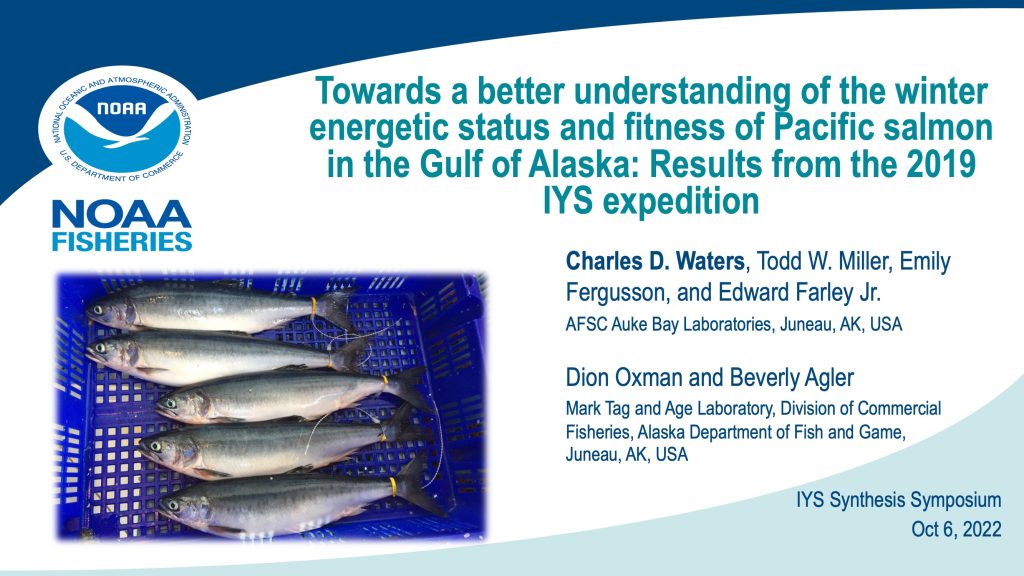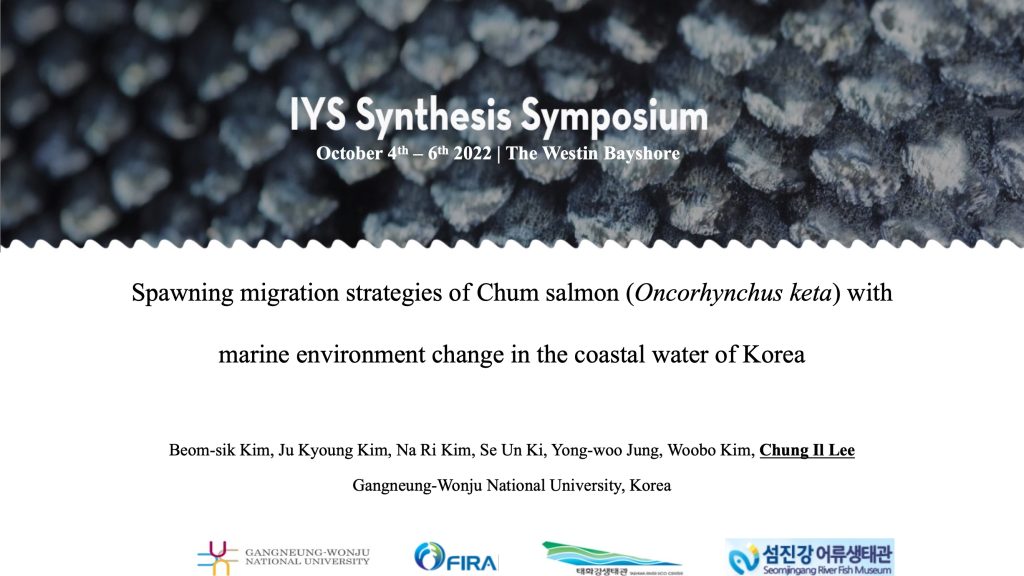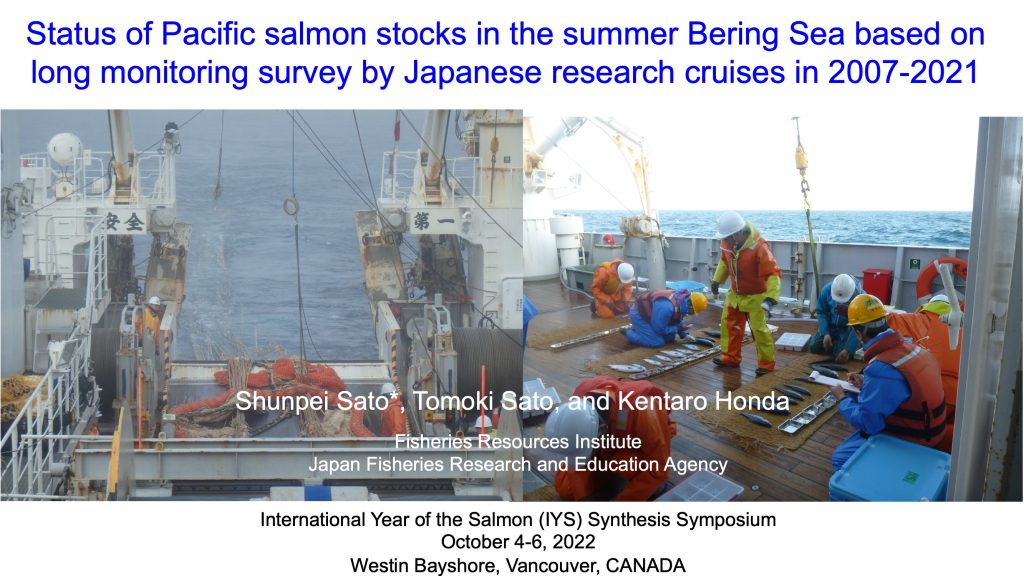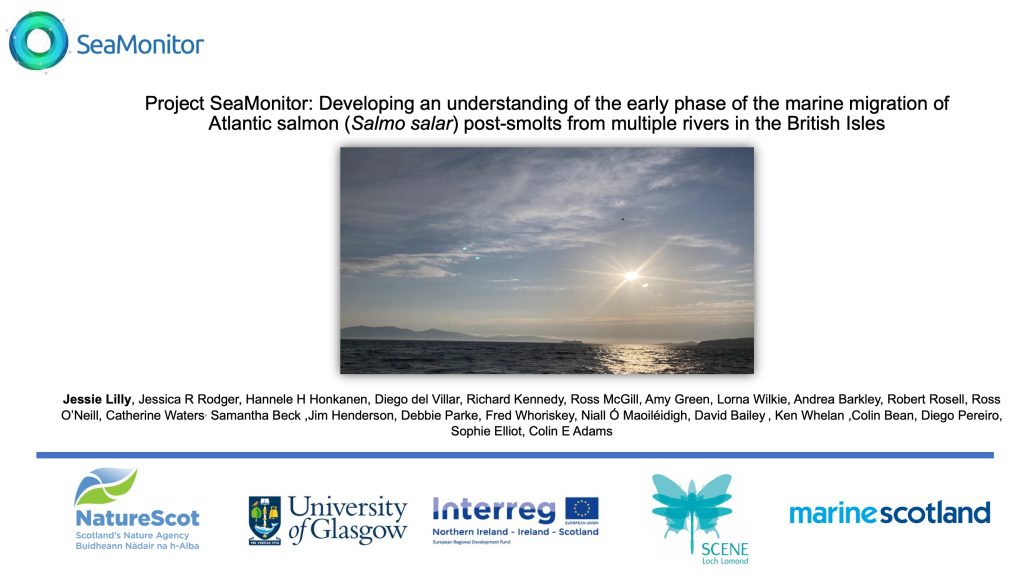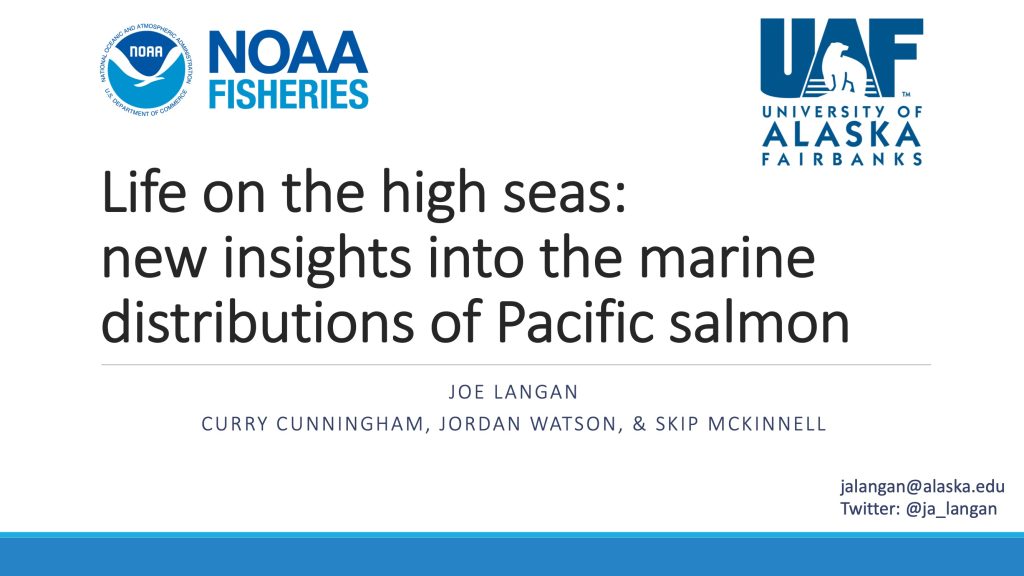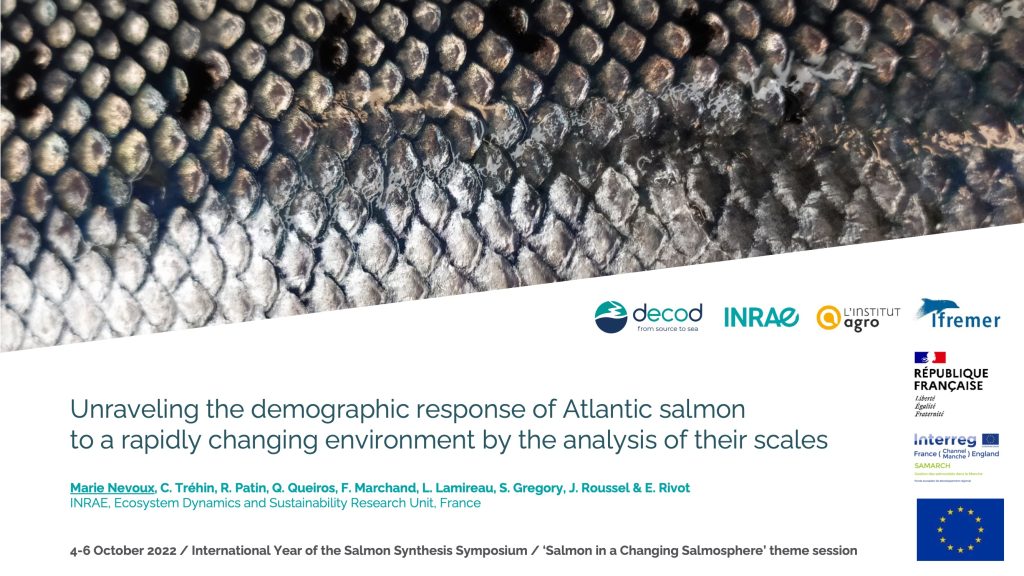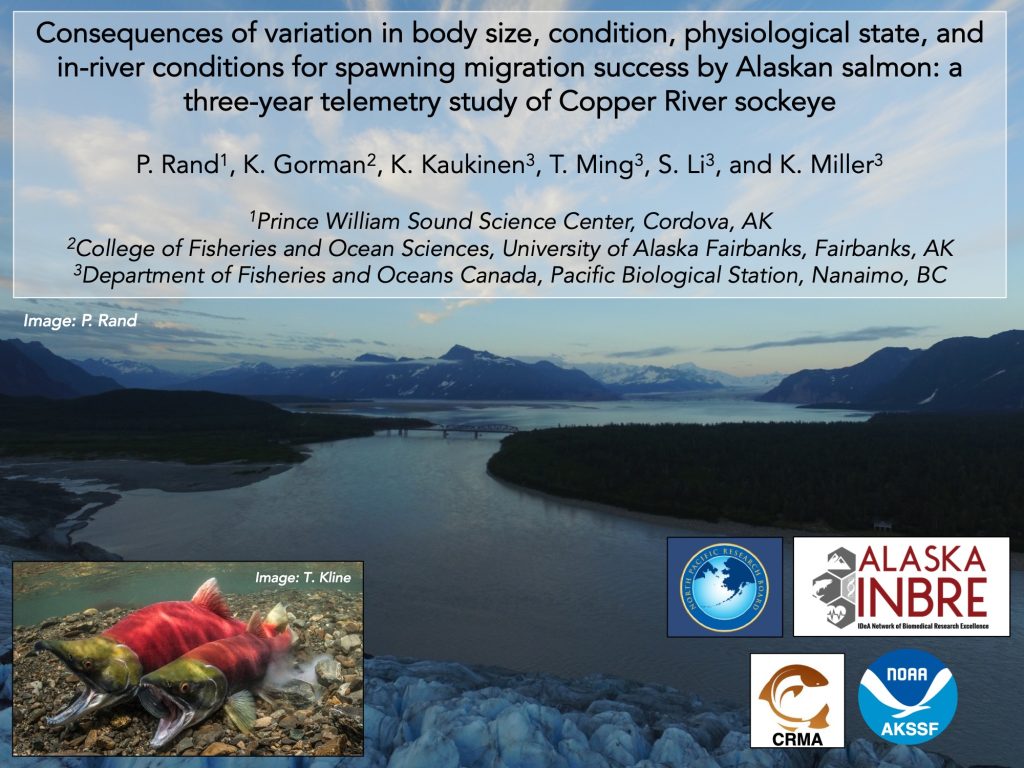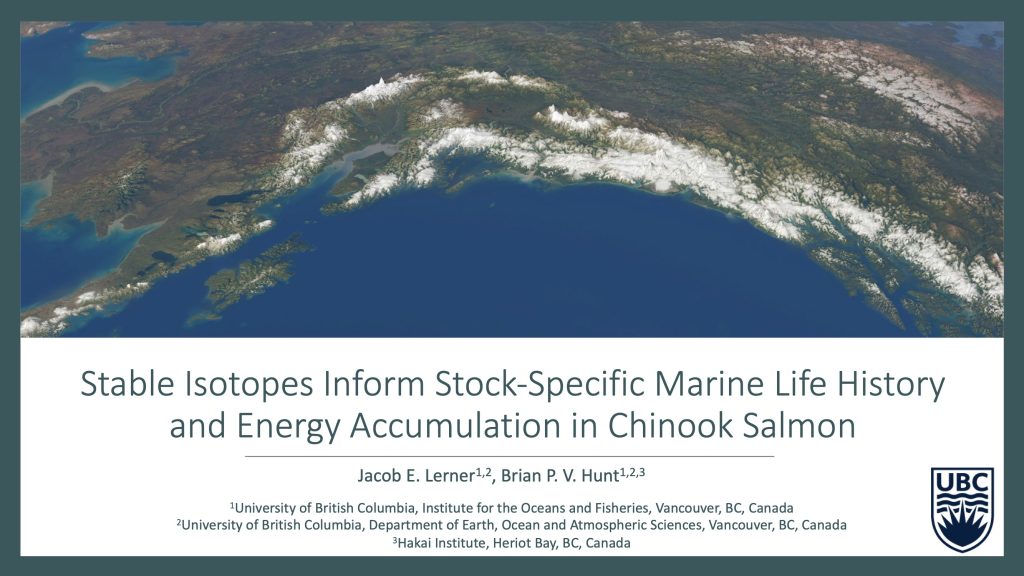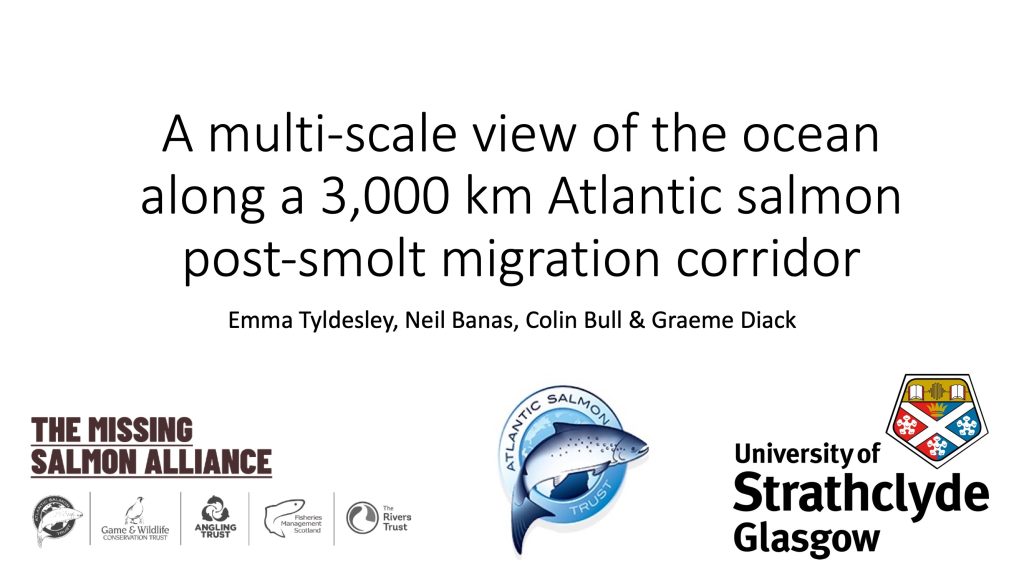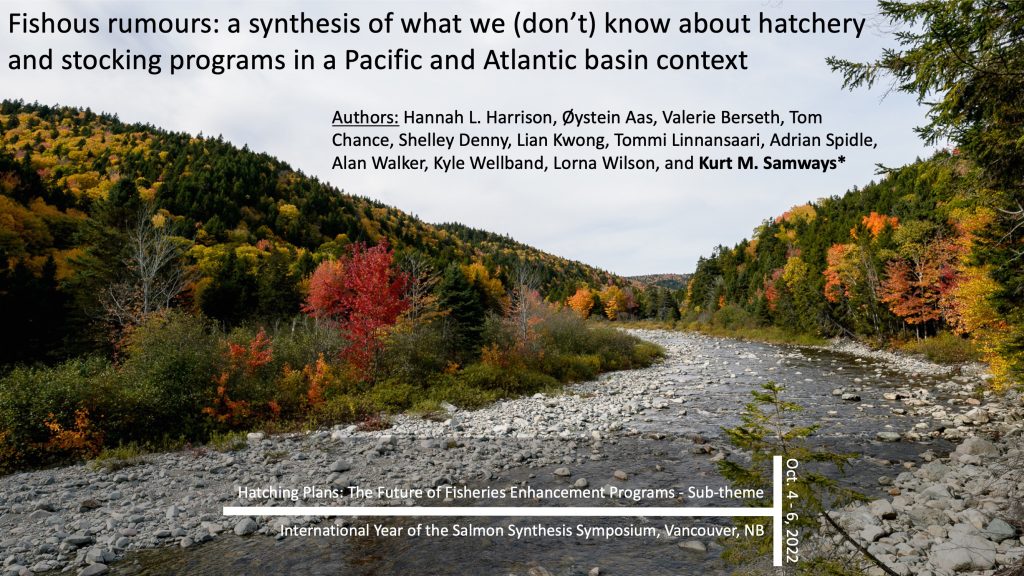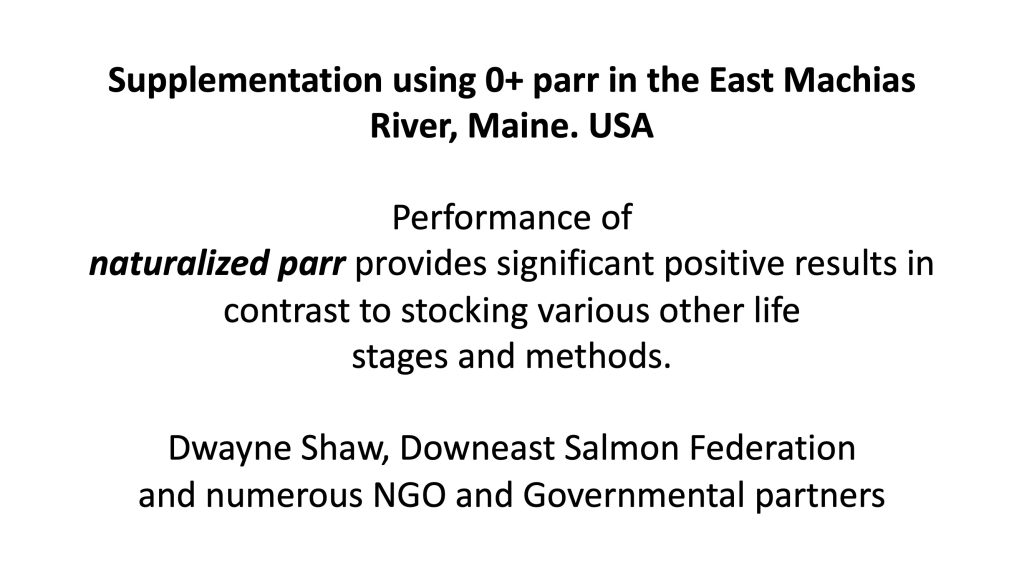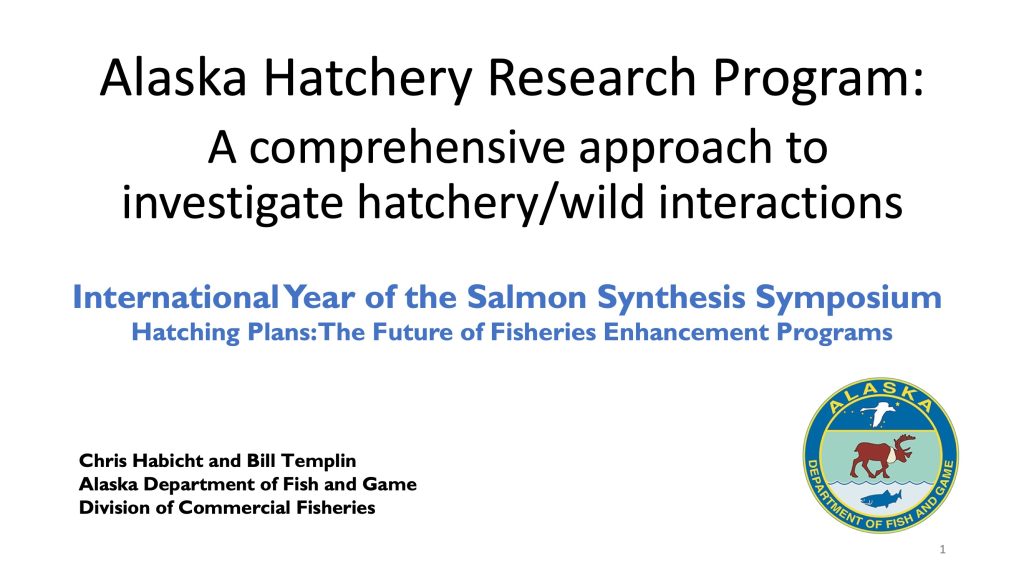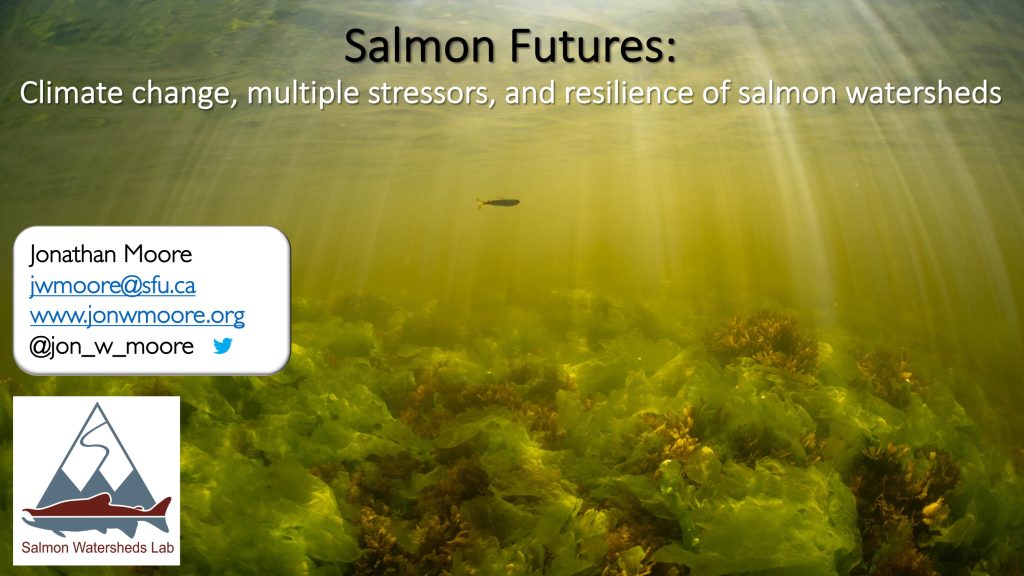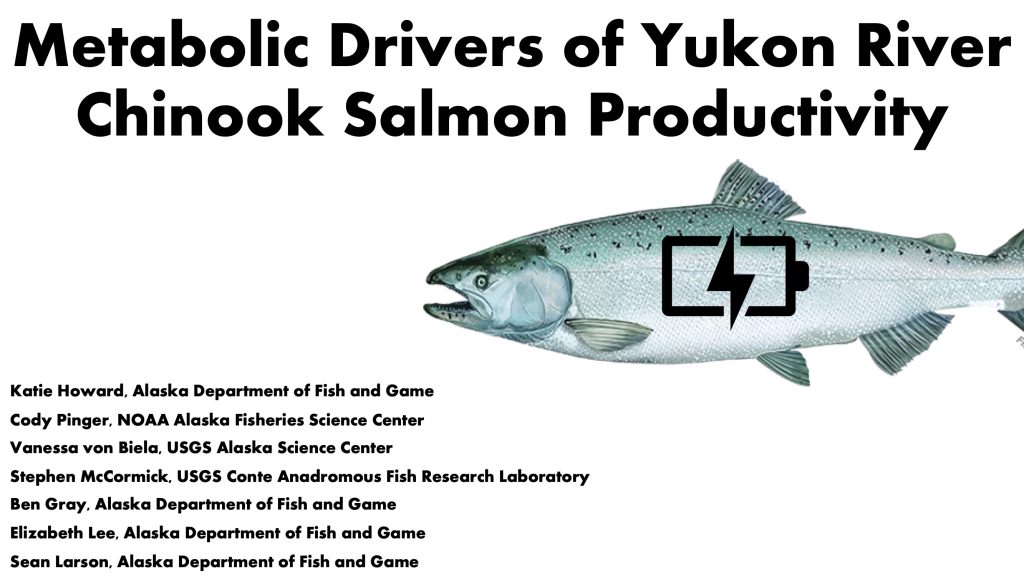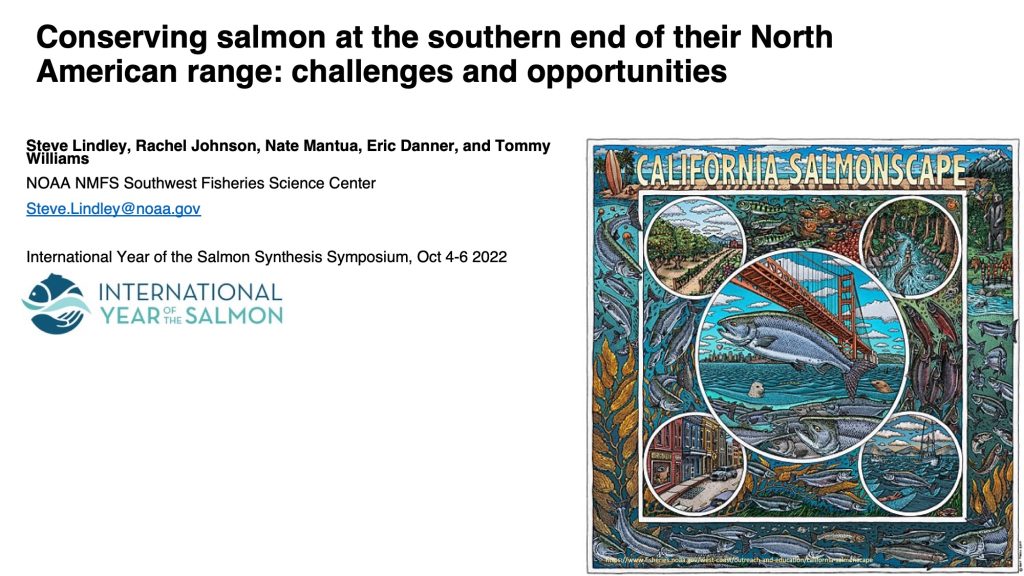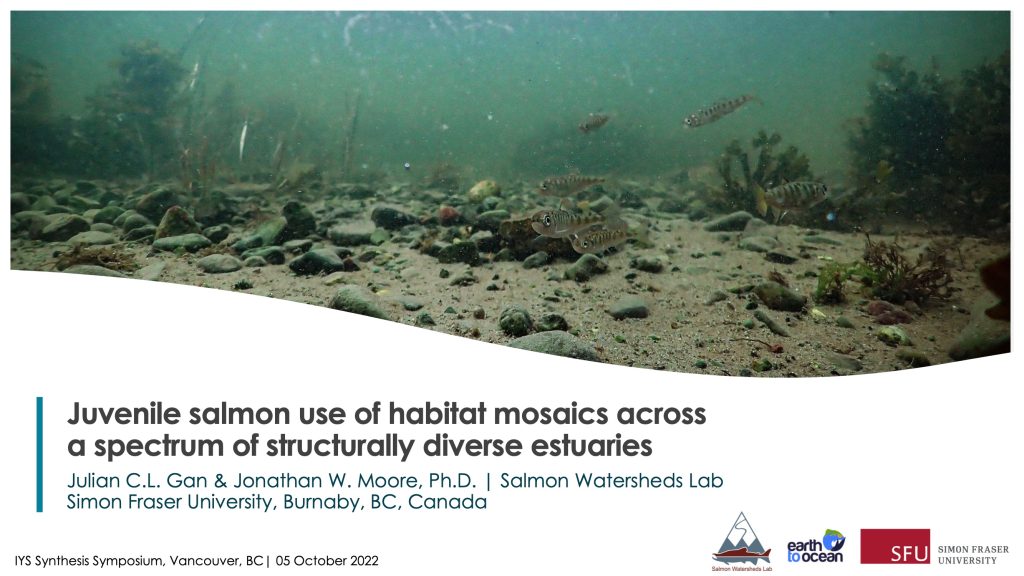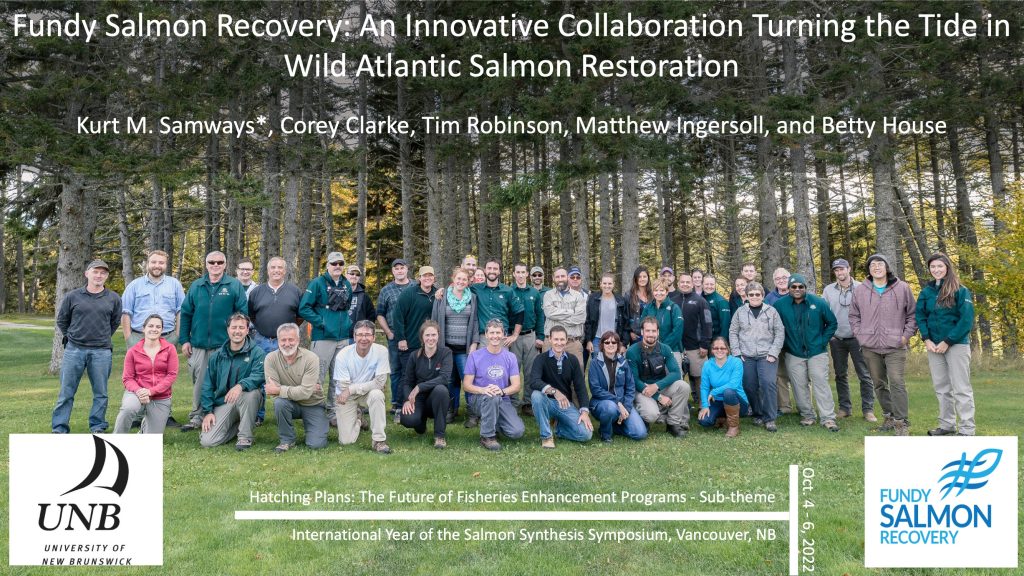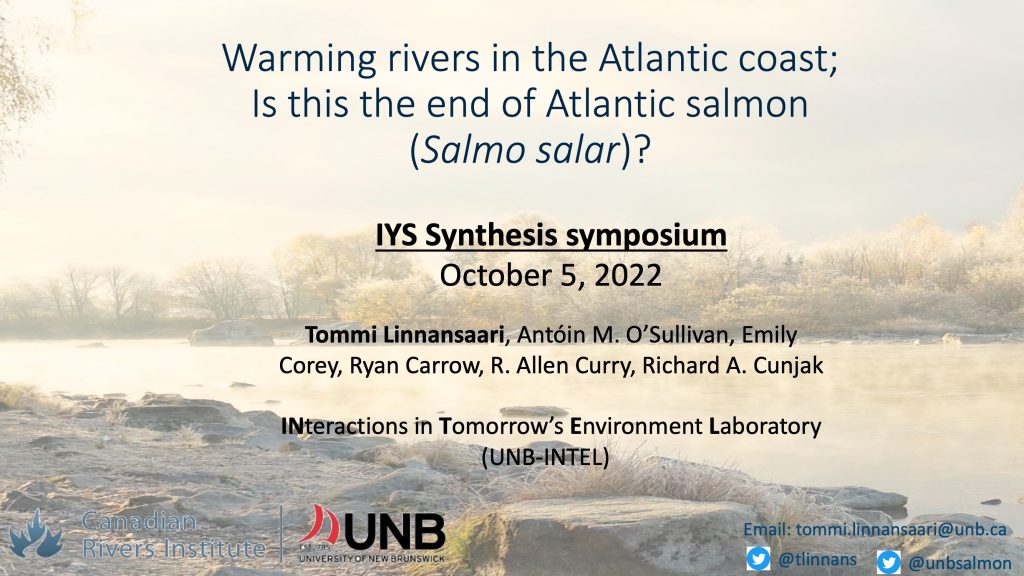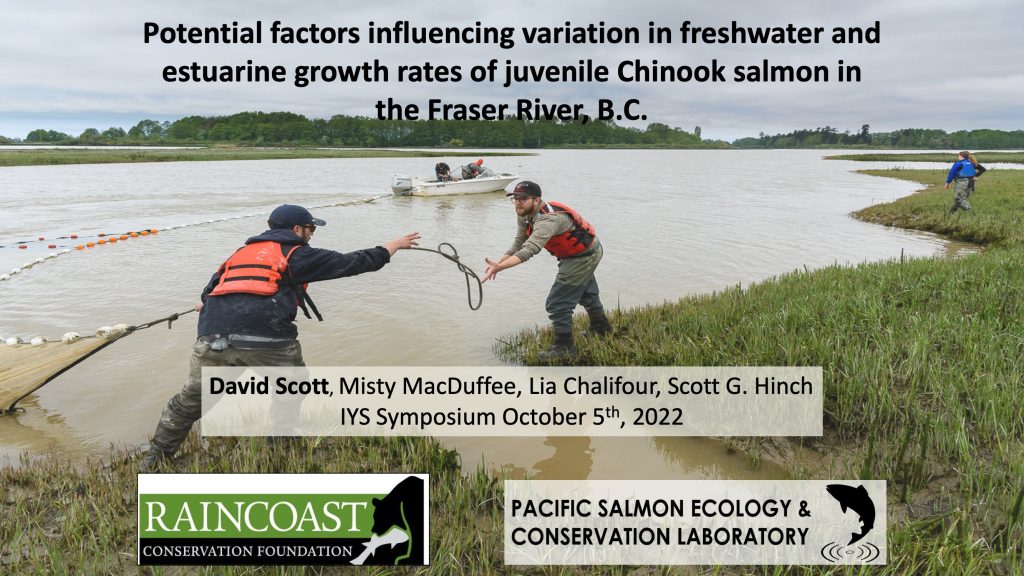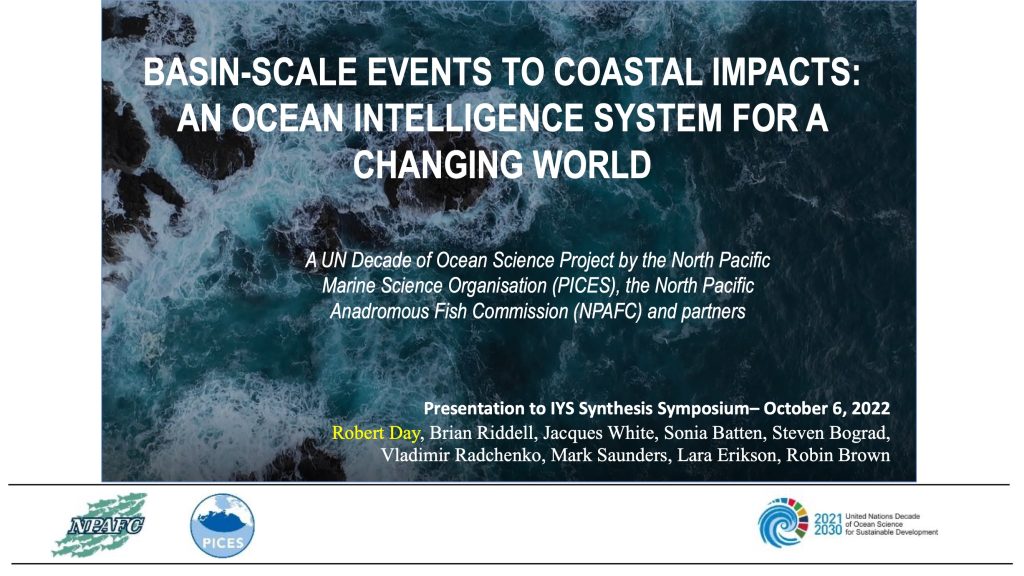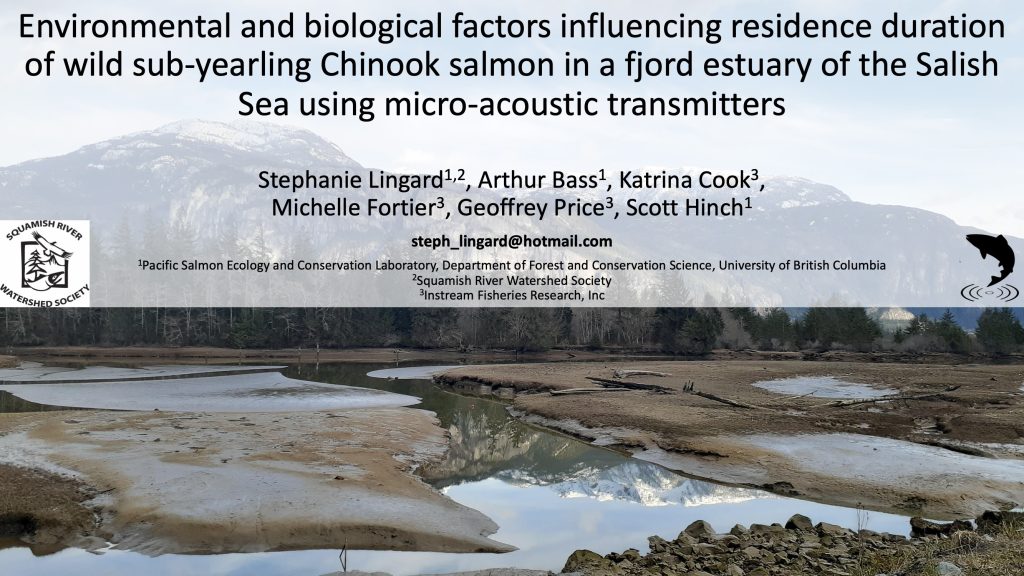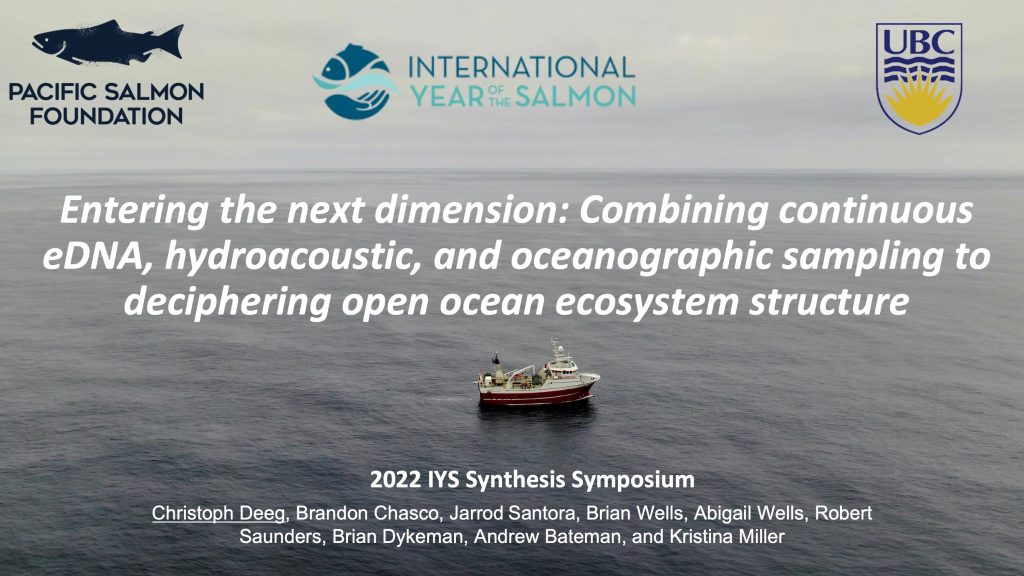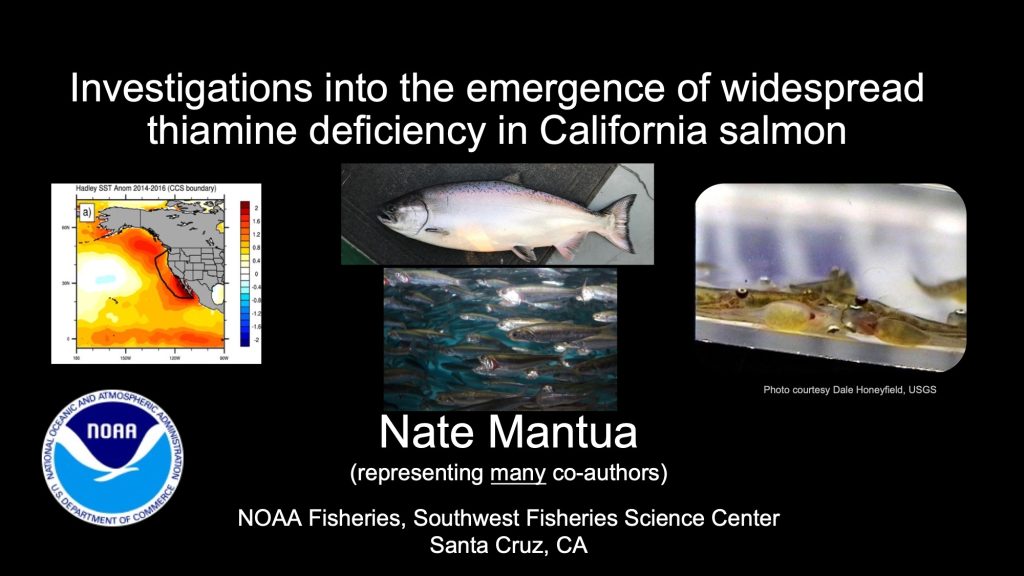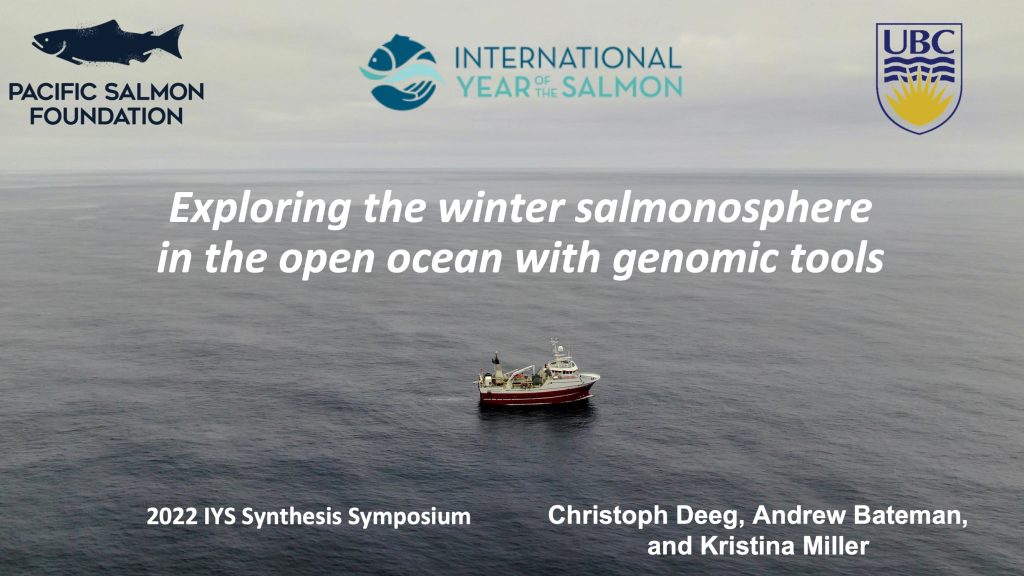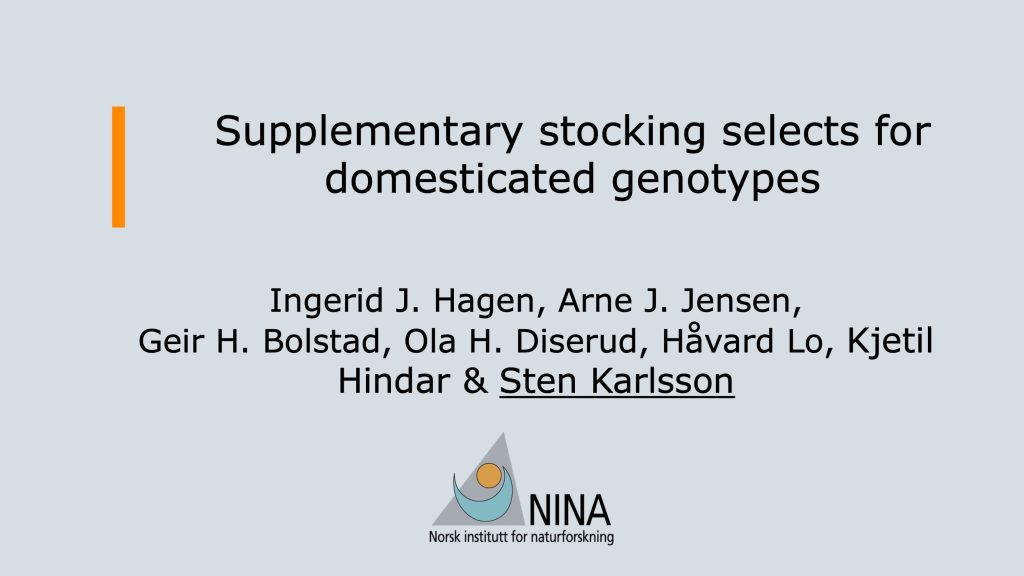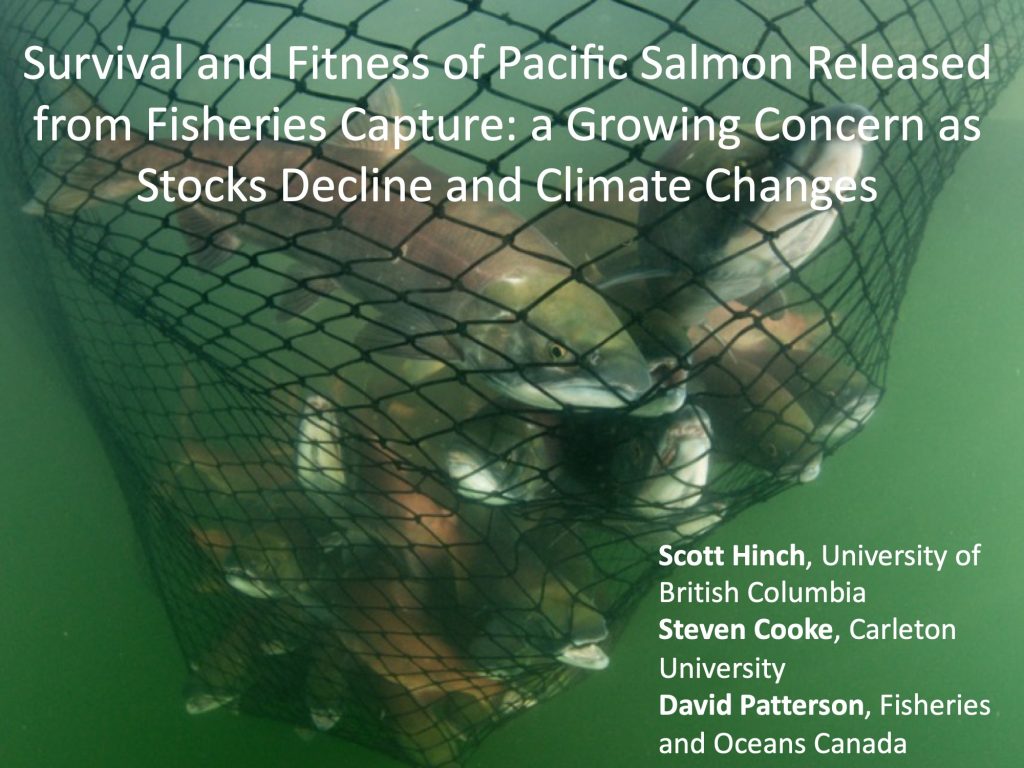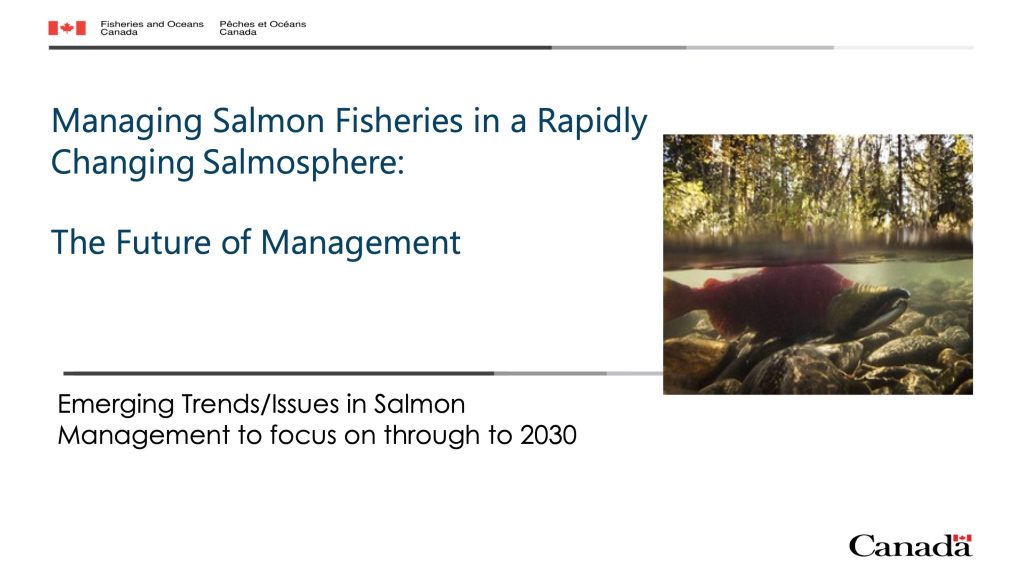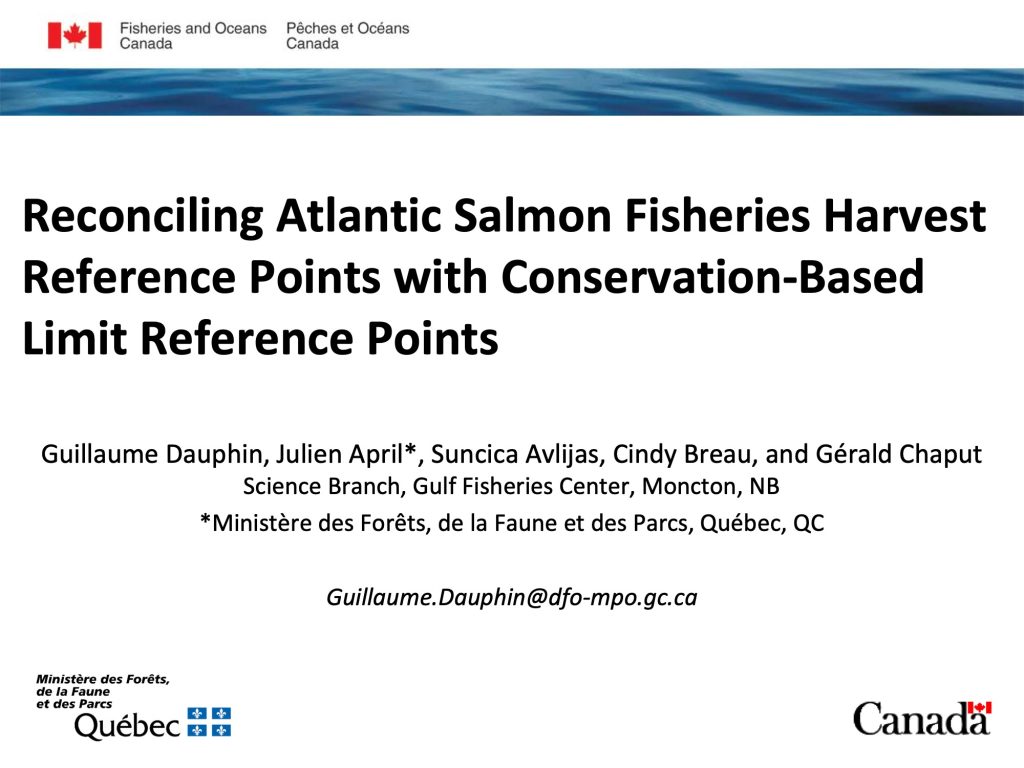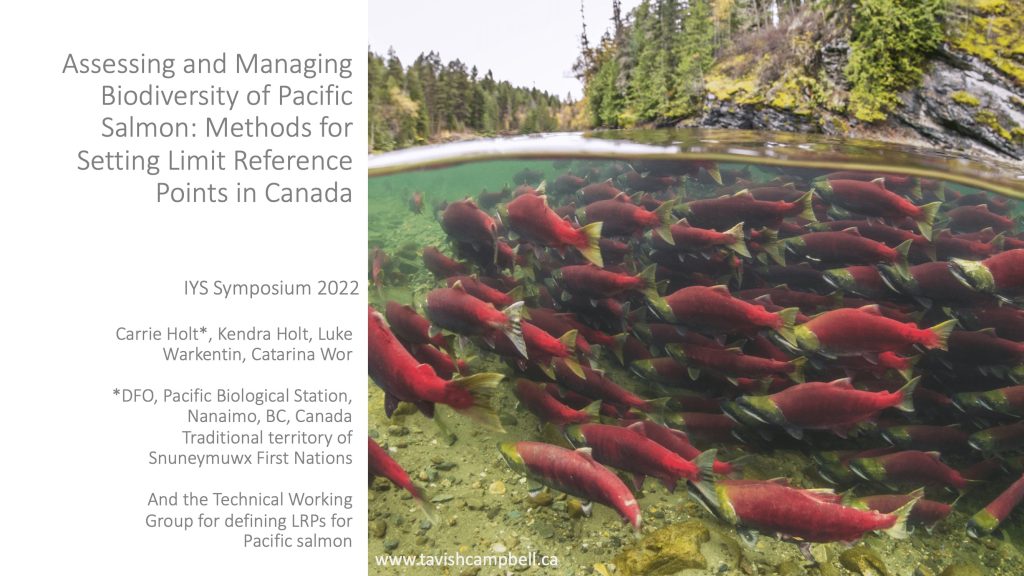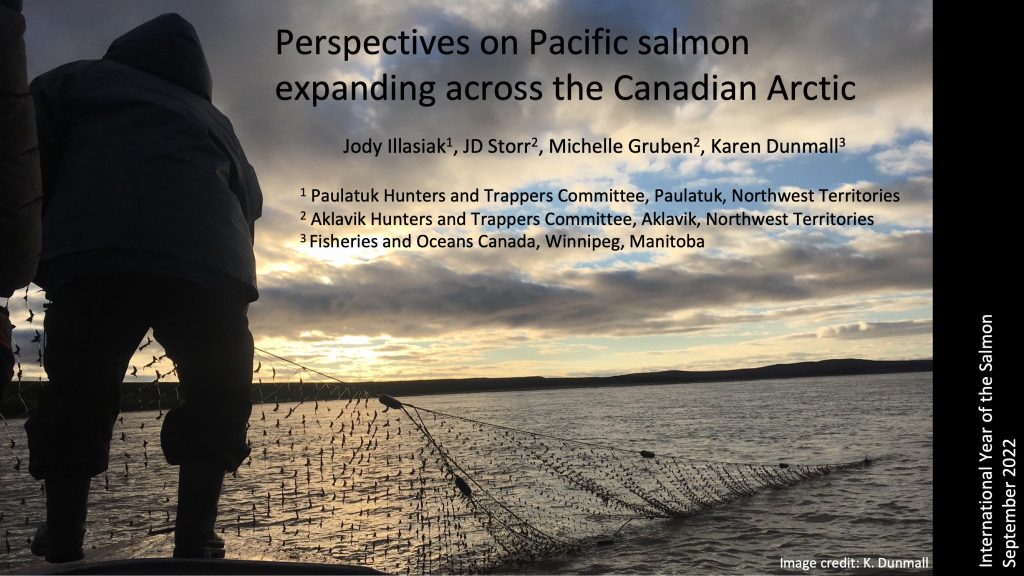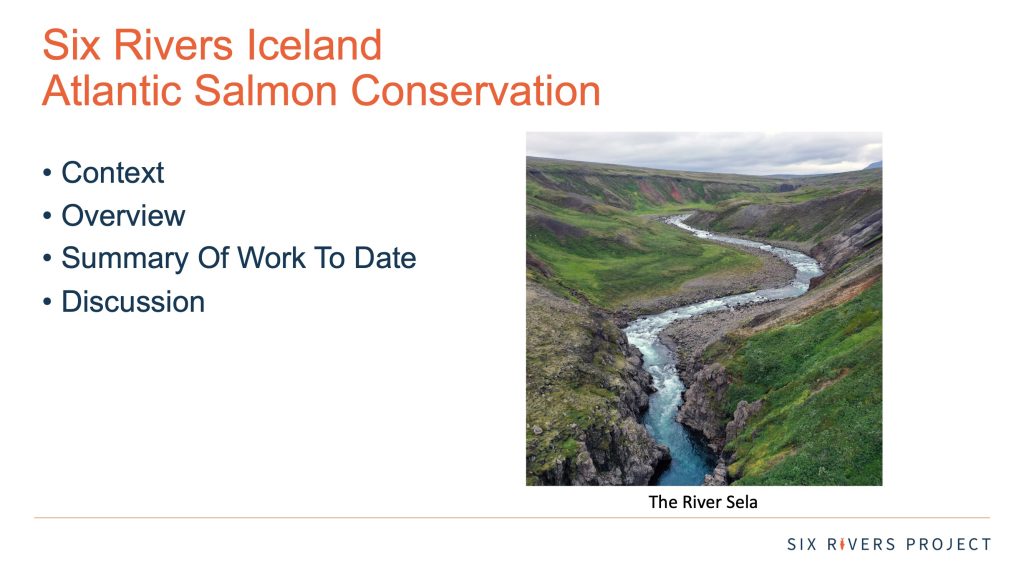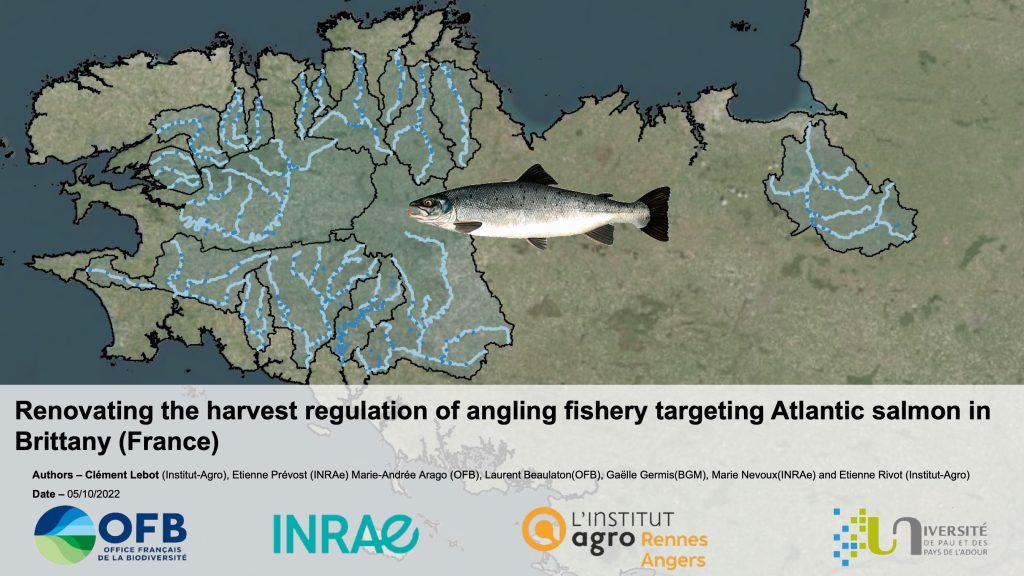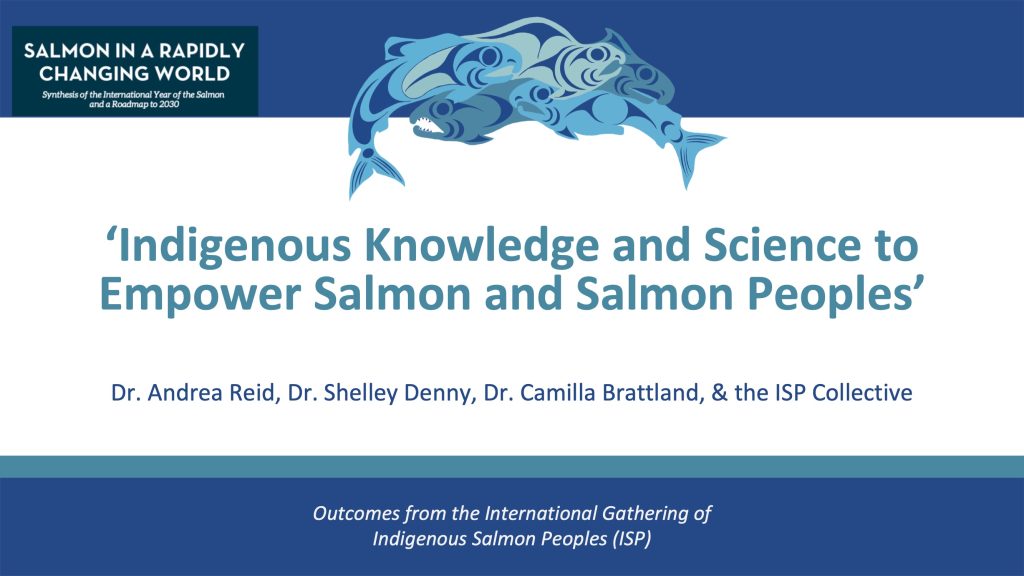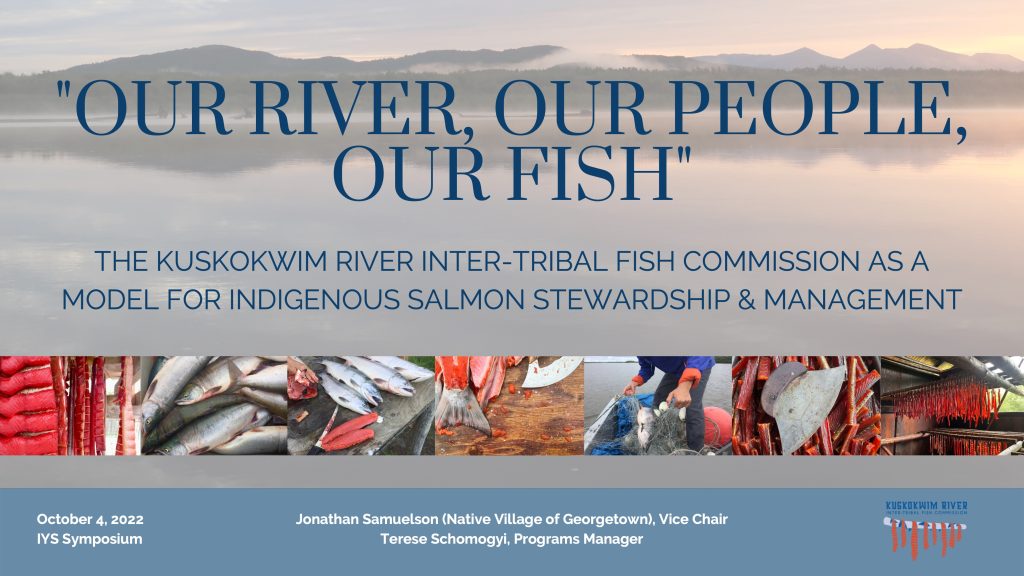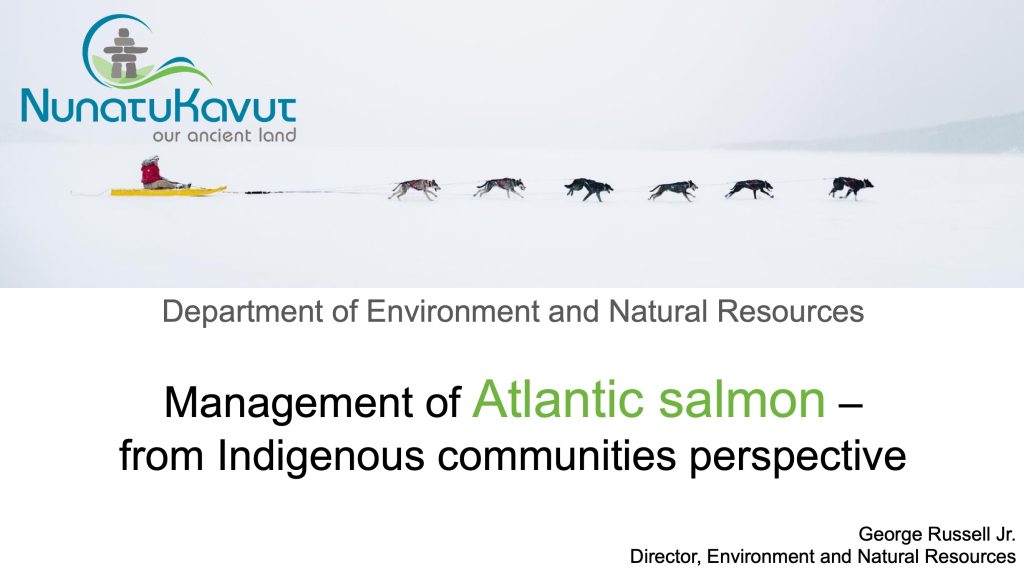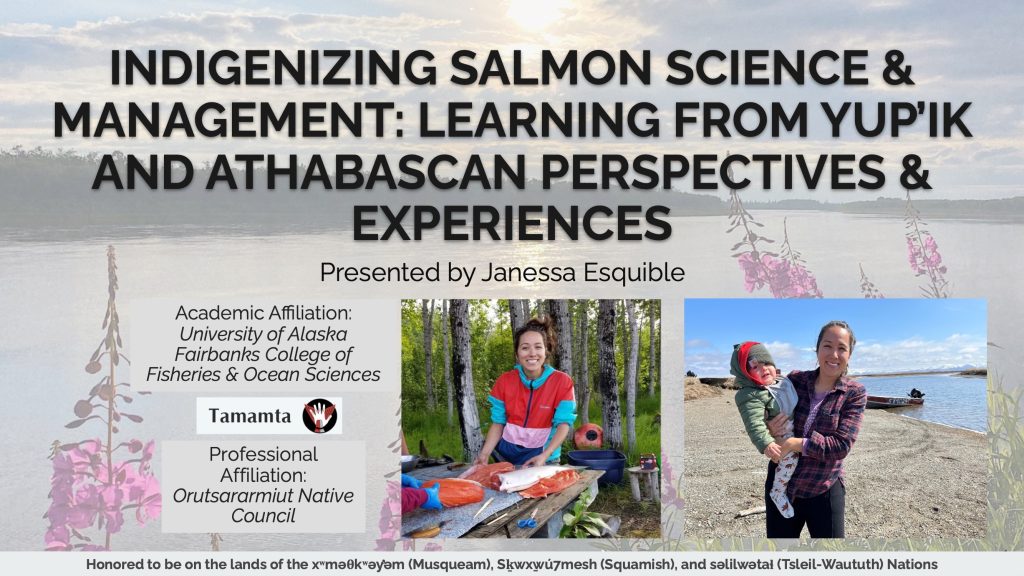Live Presentation Slide-Decks
Table of Contents
Status of Salmon
Sub-theme: The Status of Salmon across the Northern Hemisphere
Embedding Atlantic salmon stock assessment within a Bayesian life cycle modeling framework: a route toward ecosystem-based management Talk #4
Etienne Rivot, Rémi Patin, Maxime Olmos, Pierre-Yves Hervann, Marie Nevoux, Stephen Gregory, Etienne Prevost, Gérald Chaput, and colleagues of ICES WGNAS
Many wild Atlantic salmon populations have declined dramatically over the past decades. Identifying the drivers of such decline and understanding how they affect population dynamics is a prerequisite for sound science- based assessment and management of this species. This raises challenges for this anadromous fish that is exposed to multiple environmental and anthropogenic stressors at different life stages across wide ranging ecosystems and scales. This is even more challenging because available data rarely cover the full range of these scales and ecosystems and are scattered across multiple management jurisdictions. Consequently, so far, most salmon stock assessment models remain mostly phenomenological and have failed to consider ecosystem drivers of population dynamics (e.g., oceanographic conditions, prey availability). Thus, they often have limited forecasting ability, especially under changing conditions such as global warming or altered food supplies.
We developed a new stage-based life cycle model to improve our understanding of the mechanisms that shape the dynamics of Atlantic salmon populations in the North Atlantic basin and to strengthen the scientific basis of stock assessment models used by ICES Working Group for North Atlantic Salmon assessment (WGNAS). The dynamics of all stock units considered by WGNAS are jointly analyzed within a single and unified model. It allows for analyzing historical time-series of data to infer changes in both marine survival and maturation schedule over the last five decades across the North Atlantic basin. It provides a tool for evaluating the synchronicity of the signal in key life history traits among groups of populations impacted by the same drivers, and for testing hypotheses on the influence of environmental drivers in space-time domains occupied by salmon during their marine migration. To facilitate the effective use of this model for stock assessment by ICES, we have developed an online database and a web interface that strengthen the robustness of the workflow from data processing to hindcasting and management scenarios evaluation.
The new modelling framework hence constitutes an important tool for future improvement of our understanding of the drivers and mechanisms that shape the dynamic of Atlantic salmon populations. It is easily expandable, favors data mobilization and the assimilation of new sources of information when they become available. It offers an analytical framework to test ecological hypotheses and to provide more realistic assessments and forecasts based on a more complete understanding of the drivers governing Atlantic salmon productivity.
Chum salmon in the Canadian Arctic tell a story of resilience amidst change Talk #5
Karen Dunmall, Jody Illasiak, JD Storr, and the entire Arctic Salmon Team
Chum salmon have been present in the Mackenzie River, Northwest Territories, Canada for generations, perhaps even thousands of years. As such, they are resilient, presumably surviving massive freshwater and marine environmental changes, including glacial retreat, fluctuating temperatures, and shifting suitable habitats. Indeed, the presence of chum salmon in the Arctic is not new and is known to Arctic Indigenous peoples. What is perhaps surprising, however, is the apparent ability of chum salmon to respond rapidly to environmental change at the northern edge of their distribution. This is manifesting as spikes in chum salmon harvests, as these fish are caught as bycatch in subsistence fisheries targeting Arctic species in places both with and without a history of salmon harvests. It is these newest arrivals that are concerning to Indigenous harvesters due to potential disruptions to culture and also interactions with Arctic fishes. Indeed, these chum salmon are key indicators of broader ecosystem- level changes. In the marine environment, shifts in habitat suitability are facilitating distributional shifts northward. In the fresh water, these changes may improve spawning success and survival of juvenile phases. An age-0 chum salmon was recently captured in the Alaskan north slope nearshore ecosystem, and is the first juvenile Pacific salmon confirmed in the North American Arctic. Clearly, chum salmon have been present historically, are increasing recently, and can spawn successfully. Arctic habitats are currently suitable, chum salmon can respond rapidly to environmental change, and these changes are presumably generally expanding access. There is no longer a need for scientists to question whether Pacific salmon are established in the North American Arctic. Whether that represents a challenge or an opportunity, however, depends on perspective and that remains an important piece to consider when trying to understand shifts amidst all of the changes.
Sub-theme: Changing Climate, Changing Status: Understanding Shifts in Salmon Distribution, Productivity and Abundance Under Climate Change
Ocean Basin to Watershed Modeling of the North Pacific Provides a New Basis for Modeling Climate Change Impacts on Salmon … introducing the SCHISM-based model: CPOEM #Talk 10
Charles Seaton, Antonio Baptista, Mike Swirsky, David Graves, Alexander Kurapov, Greg Seroka, and Y. Joseph Zhang
The Columbia River Inter-Tribal Fish Commission (CRITFC), in partnership with NOAA and academia, has developed a new model for the Pacific Basin that seamlessly represents processes across ocean basin to estuary and watershed spatial scales. Ocean circulation models used to evaluate climate change impacts on salmon in the open ocean and coastal/estuarine domains have previously had fundamental limitations due to different models required for different spatial scales. Recent improvements in the ability of a varying-resolution (unstructured grid) circulation model to represent the eddying regime of the open ocean make it possible to create a continuous representation across basin-scale open ocean processes (such as the North Pacific Gyre currents and eddies), coastal processes (including upwelling and coastally trapped waves) and estuary and watershed processes (including river plumes, salinity intrusion in estuaries, and storm-driven rain runoff). The new model for the Pacific Basin extends from the Bering Strait to 30 degrees South latitude and incorporates high resolution representations of areas of interest, including the Columbia River estuary. It uses the modeling code SCHISM to provide a three-dimensional, tidal, baroclinic representation of the ocean. After minimal calibration, the model demonstrates cross-scale skill in representing ocean and estuary features during a one-year (2018) simulation, including basin-scale currents, coastal upwelling, coastally trapped waves, salinity intrusion within the Columbia River estuary, and basin-wide elevations, both tidal (median complex error in semi-diurnal tide of 0.08 m) and non-tidal (median root-mean-square error of 0.06 m). The Pacific model is forced using atmospheric models, river discharge, harmonic tidal models, and global ocean models at the boundaries, and it can be forced using global climate model results for climate change scenarios. It therefore has the potential to explore cross-scale interactions under climate change scenarios, such as interactions between changes in major currents and changes in coastal river plume size and timing. Although not included in the existing stage of development of this model, it can be extended to incorporate nutrient- phytoplankton-zooplankton-detritus (NPZD) models and its results can be incorporated into salmon life cycle and ecosystem modeling. Because oceanographic conditions experienced by salmon during their immediate entry and first year at sea are critical to overall survival and growth of a given year class, improving the resolution and quality of oceanographic data will help explain more variation in current and projected estimates of salmon productivity.
Status and trend of production of Japanese chum salmon under the warming climate Talk #11
Masahide Kaeriyama
In this century, Pacific salmon (Oncorhynchus spp.) productivity have declined in southern areas but increased in northern areas owing to a warming climate in the North Pacific Ocean. Return of Japanese chum salmon (O. keta), mainly hatchery-produced fish, has exponentially decreased in this century. Salmon are roughly divided into two populations: cold-current populations (CCPs) affected by the Oyashio cold current, and warm-current populations (WCPs) affected by the Tsushima warm current in Japan. The decreasing tendency of the population size of CCPs was greater than that of WCPs, suggesting that WCPs are relatively more adaptable to the warming climate. Based on the Lotka–Volterra competition model of intra-specific interactions between Japanese and Russian chum salmon sympatrically distributed in the Sea of Okhotsk, against Russian chum salmon, Japanese chum salmon was the winner until the 2011 brood year, and became coexistent or a loser after that. According to the scale back-calculation of adult chum salmon returning to the Tsugaruishi River, increased fork length (Lc) of juvenile salmon in the coast area showed significantly declining temporal-trend and positive-correlation with survival rate, but their increased fork length (Lo) in the Sea of Okhotsk indicated no temporal-trend and correlation with survival rate. This result supports the size-selective mortality hypothesis. In the Bering Sea, no temporal-trends were observed in increased fork lengths at age-2 and age-3 (L2, L3), but that at age-4 (L4) clearly increased over time and negatively correlated with the survival rate. This may indicate that their final growth at age-4 compensates for the spawning migration. Japanese chum salmon seems to be difficult to adapt well for the extreme warming climate in the near future. Therefore, it is necessary to establish sustainable salmon conservation management under a warming climate regime as following final goals: (1) conservation and recovery of wild salmon, and zoning between wild and hatchery-produced salmon, (2) long-term research and monitoring of interactions between aquatic ecosystems and salmon, and (3) restoration and resilience of wild salmon and river ecosystems.
Adapting Pacific salmon management systems to an increasingly warm and crowded ocean Talk #12
Brendan Connors, Greg Ruggerone, and James Irvine
The North Pacific Ocean is warming and overall salmon abundance remains high, in large part due to industrial scale hatchery production. Increasing and more variable temperatures, as well as competition among salmon at sea, have been associated with shifts in salmon productivity, body size, and age-at-maturation. These relationships vary by species, location, and over time, resulting in increased harvest opportunities in some regions and exacerbated conservation risks in others. We summarize the evidence for the effects of ocean warming and competition among salmon at sea on Pacific salmon, identify key knowledge gaps, outline opportunities to fill them, and describe where we expect new fishing opportunities to occur. We conclude with a research prospectus to improve understanding of Pacific salmon responses to changing ocean climate and competition among salmon at sea, and outline how fishery management systems might adapt to better utilize increases in overall salmon abundance while mitigating the adverse consequences of it for at-risk populations. Improved communication and collaboration among North Pacific fishery research and management agencies will be key to balancing the benefits and risks of a warming and more crowded ocean.
Pink Salmon in the North American Arctic Talk #61
Elizabeth Lee, Karen Dunmall, Sten Karlsson, Julien April, Tyler Dann, Sara Gilk-Baumer, and Chris Habicht
Climate and human induced shifts in Pink Salmon distribution have been documented across the Northern Hemisphere, including expansion into Arctic regions. An improved understanding of the origin of invading salmon populations will benefit research and management of the species. We present genetic observations of Pink Salmon (Oncorhynchus gorbuscha) expansions into the Alaskan and Canadian Arctic to shed light on the relative roles of climate and human influences on the distribution and establishment of these invading salmon. To do this, we genotyped baseline Pink Salmon collections from the natural range across the Pacific Rim, from Norwegian rivers that represent secondary colonizations from stocking operations in the White Sea, and from the Great Lakes that represent secondary colonizations from an accidental release. We then genotyped samples of invading Arctic Pink Salmon for evidence of: origin, deviation from the strict 2-year life history found in their natal range (but not in some introduced areas), and self-sustaining populations. For origin, we test the hypothesis that North American Arctic individuals originate from natural colonization from the Pacific Ocean, from the Russian stocking in the White Sea (1956–1979; 1985–1999) of Magadan region stocks, or from the Canadian accidental release into the Great Lakes (1955) of a British Columbia stock. We screened 298 amplicons in a genotyping-in-thousands by sequencing panel to examine conformance to Hardy-Weinberg Equilibrium expectations, heterozygosity, and genetic relationships to baseline populations.
The early marine distribution of Atlantic salmon in the Northeast Atlantic: A genetically informed stock specific synthesis Talk #62
John Gilbey, Vidar Wennevik, Kjell Utne, Philip McGinnity, and Eric Verspoor
The survival of Atlantic salmon (Salmo salar) has declined dramatically during its marine phase with presumed disproportionate impacts on the poorly understood early post-smolt period. To advance understanding of post-smolt distributional ecology in the North-east Atlantic, a comprehensive collation and analysis of existing information was undertaken. Data were synthesized from 385 marine cruises, 10,202 individual trawls, and 9,269 captured post-smolts, spanning three decades and ~4.75 million km2 of ocean, with 3,423 individuals genetically assigned to regional phylogeographic origin. The findings confirm major migrational post-smolt aggregations on the continental shelf-edge off Ireland, Scotland and Norway, and an important marine foraging area in the Norwegian Sea. Genetic analysis shows that aggregational stock composition does not simply reflect distance to natal rivers, with northern phylogeographic stock groups significantly under-represented in sampled high-seas aggregations. It identifies a key foraging habitat for southern European post-smolts located in international waters immediately west of the Vøring Plateau escarpment, potentially exposing them to a high by-catch mortality from extra-territorial pelagic fisheries. Evidence of the differential distribution of regional stocks points to fundamental differences in their migration behaviours and may lead to inter-stock variation in responses to environmental change and marine survival. The study shows that understanding of post-smolt marine ecology, as regards to stock-specific variations in habitat utilization, biological performance and exposure to mortality factors, can be significantly advanced by data integration across studies and exploiting genetic approaches. However, the temporal and spatial account of post-smolt distributional dynamics remains incomplete and development of a fully comprehensive account presents an extremely difficult scientific challenge.
Information Systems
Sub-theme: Towards a Data driven Future: Progress and Future Requirements for Data Mobilization across the Salmosphere
Synthesis Presentation: Salmon Data Mobilization Talk #45
Graeme Diack, Tom Bird, Scott Akenhead, Hlynur Bardarson, Jennifer Bayer, Deirdre Brophy, Colin Bull, Elvira de Eyto, Nora Hanson, Brett Johnson, Matt Jones, Alexis Knight, Bryce Mecum, Marie Nevoux, Tim van der Stap, Alan Walker, and Vidar Wennevik
The population declines faced by many salmon species globally have occurred in spite of massive research and conservation efforts. The capacity to turn these globally distributed efforts into informed management actions is limited by a lack of internationally coordinated publication of data for re-use by others. Useful resources tend to remain minimally accessible outside of their immediate participants, constraining opportunities for researchers to work collaboratively on broad-scale insights and solutions. A significant aspect of this failure to halt population declines therefore lies squarely in the domain of information logistics and management. Creating the environment in which these efforts can be shared and understood for the broader research insights they may provide—or Data mobilization (DM)—has been identified as a key step towards the research insights and informed management actions (knowledge mobilization) needed to address this crisis. Requirements for DM include the FAIR Guiding Principles, which aim to optimize the re-use of data by making them easily discoverable, with rich metadata, standard vocabulary, and clear access protocols. FAIR data practices allow for greater analytical power through improved access to the existing, rich, data resources across diverse contexts, such as those that exist for most salmon species. This wider evidence base can then in turn provide support for more effective, accountable, and reliable application of data insights to management—or knowledge mobilization (KM). While Data mobilization is growing in the research community as a whole, it has yet to penetrate deeply into the culture of salmon research and conservation. To support this transition, we assemble a variety of stakeholder perspectives to provide a salmon- focused definition of mobilized data. We review the spectrum of DM participants and identify modern and innovative methods used as well as barriers and opportunities to mobilize their data for the broader good. We present examples of DM failures and successes, discuss how these illuminate barriers to DM, and discuss approaches to removing these barriers. We broach the problem of representing complex resources within general DM innovations, e.g., Indigenous Knowledges (IK, TEK), and physical samples. Based on these reviews, we sketch a future of salmon DM and propose functional changes required to improve DM throughout the salmon community. Overall, we call for new community practices and progressive cultural adoption that facilitates wide and rapid salmon DM as befits the crisis.
The Atlantic Salmon Research Joint Venture Talk #50
Edmund Halfyard, Carole-Anne Gillis, and Alexis Knight
With both an international distribution and an anadromous life cycle, producing meaningful and broad- ranging Atlantic salmon research has historically been a complex undertaking for the scientific community.
Adequate testing of drivers of population decline such as low marine survival and freshwater habitat conditions has been slow to progress due to a lack of sufficient resources, various complexities involved in data mobilization, and a lack of overall coordination in the salmon research and conservation community. In order to respond to these issues, the Atlantic Salmon Research Joint Venture was formed in 2016 as a collective of collaborative partnerships between academic, government, non-profit and indigenous organizations to promote synergistic projects that address three priority research themes: 1) Identifying and comparing trends in abiotic and biotic historical freshwater data to determine influences on smolt condition, outmigration behaviour and marine phase mortality; 2) Investigating whether poor marine survival is the result of a genetic bottleneck selecting for specific traits, and 3) Mobilizing the collection of new information to establish linkages between freshwater conditions and the marine survival of Atlantic salmon. This research relies on combining a backwards-looking approach that collates the abundance of pre-existing high-quality data normally not shared across agencies to address historical data questions, with a forwards-looking approach that identifies understudied sites across the East coast and mobilizes resources to fill the information gaps. By pooling resources and building a sense of trust amongst previously independent stakeholders, the Joint Venture presents an example of an effective strategy for answering salmon’s big questions through collaboration.
THE INTERNATIONAL YEAR OF THE SALMON OCEAN OBSERVING SYSTEM Talk #51
Tim van der Stap and Brett Johnson
Data mobilization—the process of making data available for appropriate re-use—remains a key barrier in effective salmon management. Data is often stored in disparate, heterogeneous datasets, and integration across information systems is lacking, limiting our collective capacity to develop a mechanistic understanding of what drives salmon productivity across their complex life histories. To facilitate data sharing, citation, synthesis, meta- analyses, and management-decision support-tools, data mobilization efforts can be improved by publishing metadata records and standardized data to domain-specific repositories to make otherwise disparate salmon data discoverable, interoperable and rapidly synthesized. The International Year of the Salmon (IYS) High Seas Expeditions in 2019, 2020, and 2022 represented a significant challenge and opportunity for data mobilization efforts due to the scale, volume, and diversity of data. The North Pacific Anadromous Fish Commission partnered with the Hakai Institute to develop a strategy to mobilize data collected from the IYS High Seas Expeditions. Given the international nature of the project, a natural alignment to the United Nation’s Global Ocean Observing System was realized and the International Year of the Salmon Ocean Observing System was created. Under this framework datasets with Essential Ocean Variables were identified using metadata records and were assigned digital object identifiers to permit and encourage data citation. Metadata records were published to a web accessible data catalogue (iys.hakai.org) developed using federated architecture. Where possible, existing community and international data and metadata standards and controlled vocabularies were adopted and data were published in domain-specific repositories. However, data mobilization barriers are not only technical but also sociocultural. Drawing on lessons from the 2019 and 2020 expeditions, a standard data exchange template and a clear data sharing policy were developed in advance of the 2022 expedition. A small fraction of the data collected in the 2019 and 2020 expeditions have been published in domain-specific repositories, likely as a result of insufficient data sharing policies and clear timelines. We anticipate the 2022 pre-expedition data management guidance, data sharing policy development, and standard data exchange template will significantly improve the sociocultural adoption of data sharing and citation practices. Both the sociocultural solutions and technical infrastructure developed during the IYS lay a foundation and clear path forward for international salmon data exchange and will continue to evolve with the United Nations endorsed Basin Events to Coastal Impacts project, deepening the impact and legacy of the International Year of the Salmon.
Salmon in a Changing Salmosphere
Sub-theme: Examining the Likely Suspects: Developments in a Wholistic Understanding of Salmon Marine and Freshwater Survival
The Likely Suspects Framework for Atlantic salmon: cooperatively building the foundations for a life-cycle approach to guide future management Talk #28
Colin Bull
This paper outlines the importance, relevance and new opportunities offered by the development of the Likely Suspects Framework approach to the future of Atlantic salmon management. It presents an update on the progress of the programme being led by the UK Missing Salmon Alliance, advancing a series of linked work packages focused upon the provision of new decision-support tools for salmon managers to assist their efforts to address the salmon crisis. It is developing and delivering tools that help strengthen resource sharing and knowledge exchange amongst the research, resource and salmon management communities spanning both the freshwater and ocean stages of the salmons’ life.
The programme is advancing multiple components of a mortality framework for Atlantic salmon that highlight the importance of taking a whole life-cycle view when formulating future management plans for threatened salmon resources. This framework is organised around a model representation of state and life stage survival changes, and on using this to focus cooperative attention on advancing our understanding of the processes and controls over salmon survival throughout the lifecycle. By representing stage and lifetime mortality variation, and highlighting potential bottleneck points and influencers, it sets out a theoretical framework for testing priority mortality- hypotheses, linked to key life-stage domains.
New knowledge for the development of the mortality framework and management decision support outputs is being provided by undertaking a use-case implementation study on a sub-set of well-studied southern European salmon stocks. Drawing together novel data synthesis and modelling techniques this programme is testing priority hypotheses concerning the drivers of mortality variation during the initial post-smolt marine migration phase (0–3 months), when mortality is generally considered to be highly variable and potentially influenced by body size and condition. By evaluating newly-synthesized, variously scaled and time-lagged ecosystem signals we are gaining new insights on the possible controls over early marine survival fluctuation, and the potential for utilising new ecosystem condition signals as indicators when building future survival forecasts.
A purpose-built, shared, data repository supports the Likely Suspects Framework programme development.
This interoperable resource also promotes wider access to resources by the research and management communities, and the evaluation of novel ecosystem indicators that may play important roles in the movement towards adopting a wider ecosystem-based approach for future salmon management. Advanced user-interface applications are being developed as framework outputs that provide novel scenario-testing capabilities for salmon managers, contributing new and effective decision-support regarding the efficiencies and scale of actions necessary to conserve stocks, and promote recovery.
RISK ASSESSMENT METHOD FOR SALMON (RAMS): IMPLEMENTATION AND LESSONS LEARNED Talk #32
Wilf Luedke, Isobel Pearsall, and Marc Labrie
DFO has developed a risk assessment methodology for salmon (RAMS) to aid in the identification and prioritization of factors that limit salmon production, both now and within the context of climate change anticipated to occur by 2050. This methodology was originally adapted from a framework on “Ecological Risk Assessment for the Effects of Fishing” (ERAEF) initially developed to inform an ecosystem-based approach to fisheries management in Australia (Hobday et al. 2011), with modifications based on work by Roni and Beechie (2013) and many others.
RAMS uses a life history model approach, relating salmon population status to the status of its habitat and ecosystem, informed by habitat state and pressure indicators. Factors limiting to productivity and capacity of the population are identified and ranked, followed by determination of the sources of habitat and ecosystem degradation. The RAMS process and associated tools for its application are designed to be highly scalable such that they can be applied to assess risk of limiting factors focused on a single life-stage of a salmon population, the entire life history of a single population, multiple populations comprising a wild salmon conservation unit (CU) or multiple CUs comprising a fisheries management unit (MU).
The approach uses available species, stock, and local knowledge as well as literature/expert opinion to conduct an initial assessment of risks and identification of knowledge gaps. Results allow for prioritization of research, assessment and fisheries management responses, such as restoration, enhancement and modification of harvest strategies outcomes. The process is iterative whereby directed research improves understanding and likelihood that mitigation will be successful. Moreover, as with the central tenant of Martin et al. (2012), the benefit/cost ratio of restoration options is a key outcome.
This talk describes the RAMS process, the application of a simplified life cycle model to examine interaction with physical and biological processes, the iterative approach to assessing risk, identifying and directing research, and developing mitigative options which form the basis of a rebuilding plan. Finally, we provide examples of the application of RAMS in rebuilding processes for Cowichan River and West Coast Vancouver Island Chinook.
A synthesis of farmed to wild genetic introgression and the consequences for wild Atlantic salmon Talk #34
Sten Karlsson, Tonje Aronsen, Geir H. Bolstad, Ola H. Diserud, Peder Fiske, Ingerid J. Hagen, Kjetil Hindar, Eli Kvingedal, Line E. Sundt-Hansen, Grethe Robertsen, and Sebastian Wacker
Atlantic salmon farming is one of the fastest-growing food industries and farmed salmon now outnumber wild Atlantic salmon 1000-fold. This unprecedented growth has been accompanied by numerous concerns about the impact it has on wild Atlantic salmon. Genetic introgression from farmed escapees is possibly the most important threat with severe and long-term effects on the productivity and viability of wild Atlantic salmon populations. The magnitude of escaped farmed salmon and level of genetic introgression are well documented. There is a growing body of evidence that genetic introgression leads to changes in important life history characteristics and a reduction in fitness of wild salmon. Because of this knowledge base, Atlantic salmon has emerged as a model organism for understanding the impact of aquaculture on wild fish. Here we present a synthesis of the knowledge gained of genetic interactions and consequences for wild Atlantic salmon, lessons learnt, and advice for sustainable development of aquaculture.
Sub-theme: Opening the Black Box: Advances in Understanding the Marine Phase of the Salmon Lifecycle
Illuminating the black box of North Pacific salmon food webs: identifying trophic pathways and interspecific competition through an ecosystem approach Talk #42
Genyffer C. Troina, Evgeny A. Pakhomov, Aleksey Somov, and Brian P. V. Hunt
Understanding food web structure and dynamics is key to accurately quantifying species interactions, identifying the main trophic pathways that sustain salmon and apex predators, and evaluating the effects of climate changes on ecosystem stability. Oceanographic and trawl sampling completed during the 2019 International Year of the Salmon expedition to the Gulf of Alaska (GoA) provided a rare opportunity to assess high seas salmon food webs in the eastern North Pacific. Using samples collected during this expedition our main goal was to characterize the trophic connections within the GoA food webs that sustain salmon during winter (Feb–Mar), and how they vary spatially according to gradients in oceanographic conditions. We analyzed salmon stomach contents, as well as carbon (δ13C) and nitrogen (δ15N) stable isotopes in samples of particulate organic matter, zooplankton, jellyfish, squids, and fish (including salmon). Isotope data were used to estimate the trophic position (TP) of the different food web components, and their isotopic niche areas as a proxy of trophic niche. Two different subareas were identified within the GoA based on a hierarchical cluster analysis using oceanographic data. Lower temperatures, higher salinity and nutrient concentrations were found in the northwestern Gulf of Alaska (NW-GoA) in comparison to stations sampled in the southeast (SE-GoA), the former reflecting the influence of the Alaska Gyre. In both regions, three main trophic groups were identified: primary consumers—mesozooplankton taxa / size fractions (TPs 2.0– 2.8); secondary consumers—chum, squids, and jellyfish (TPs 2.8–3.3); and tertiary consumers—myctophids, pink, sockeye, chinook, coho, and spiny dogfish. Salmon TP did not differ between those caught in the NW-GoA and their SE-GoA conspecifics. In the NW-GoA, euphausiids appeared to be the dominant pathway between phytoplankton and salmon. High isotopic similarity and niche overlap among myctophids, squids, chum and sockeye in the NW-GoA indicated that they consumed isotopically similar prey and might compete for resources.
Conversely, in the SE-GoA salmon consumed a greater variety of prey and this appeared to allow for more resource segregation among species, with only pink salmon seeming to compete with myctophids and squid. This study builds on previous works on the feeding ecology of salmon in the high seas, and takes a step forward through an ecosystem-based approach that sheds light on direct and indirect trophic relationships, including competition with non-salmonid species, that might cascade through the food web and affect salmon growth and survival.
Towards a better understanding of the winter energetic status and fitness of Pacific salmon in the Gulf of Alaska: Results from the 2019 IYS expedition Talk #43
Charles D. Waters, Todd W. Miller, Emily Fergusson, Edward Farley Jr., Dion Oxman, and Beverly Agler
A comprehensive understanding of factors that regulate the productivity of Pacific salmon is needed for their effective management and conservation, particularly with changing environmental conditions such as the recent marine heatwaves in the North Pacific Ocean. Winter is considered to be a critical period for Pacific salmon, where overwinter survival is likely dependent on their ability to acquire sufficient lipid reserves in the preceding summer and fall. Yet, we do not fully understand the winter energetic status and fitness of the different age classes for each species or the extent to which intra- and inter-specific competition may exist. Competition may be further intensified by large-scale hatchery releases of pink and chum salmon. Here, we assessed the winter energetic status and fitness of Pacific salmon by estimating their energy density, lipid content, and protein content from samples of muscle tissue collected in the Gulf of Alaska in winter 2019. We then estimated the hatchery component of chum and pink salmon by examining otoliths to determine the presence of a thermal mark (hatchery origin), which allows us to better understand the potential for competition between hatchery and wild salmon that may occur in the marine environment. Energy densities between chum, coho, pink, and sockeye salmon were similar despite different prey preferences and feeding intensities, which may reflect general winter energetic conditions in the Gulf of Alaska.
Lipid and protein content suggest that chum salmon were in moderate condition during winter 2019, whereas coho, pink, and sockeye salmon were in poor condition. No differences in energy density were observed between hatchery and wild chum salmon from Alaska, suggesting that fish of both origins may be responding similarly to winter conditions. These results provide important insight regarding the fitness of Pacific salmon during the critical winter period, although our findings must be paired with data from additional years before more definitive interpretations can be made.
Spawning migration strategies of Chum salmon (Oncorhynchus keta) with marine environment change in the coastal water of Korea Talk #46
Beom-sik Kim, Ju Kyoung Kim, Na Ri Kim, Se Un Ki, Yong-woo Jung, Woobo Kim, and Chung Il Lee
The eastern coastal water of Korea, southern limit of Chum salmon (Oncorhynchus keta) distribution in the north Pacific Ocean, has the largest density of salmon migrating to Korean rivers. The coastal water forms the boundary between a low saline, cold water mass flowing from the north to the south and a high saline, warm water mass flowing from the south to the north. Spawning migration strategies of salmon in the coastal water is important for spawning success with energy reserve. We analyzed the relationship between marine environment change (sea water temperature, tidal elevations) and spawning migration of salmon in the coastal water. In the coastal water, the salmon actively moved between upper and lower layer and migrates into the river at night when sea level rose during high tide. Salmon migrated into the river when sea surface water temperature was between 12-20ºC, and actively migrated into the river when sea surface water temperature decreased below 18ºC. The number of salmon ascending the river peaked when the water column was vertically mixed by spring tides. The latitudinal distribution of salmon from northern part to the southern part in the coastal water was changed according to the distribution of sea surface water temperature along the coastal water, and timing of migrate into river from the coast was highly related with tides. In conclusion, in the process of reaching the spawning grounds, salmon chooses strategies to reduce energy expenditure by using optimal environmental conditions. This study provides important information in understanding of the mechanisms that regulate the distribution of salmon in coastal and river during spawning migration.
Status of Pacific salmon stocks in the summer Bering Sea based on long monitoring survey by Japanese research cruises in 2007-2021 Talk #47
Shunpei Sato, Tomoki Sato, and Kentaro Honda
Pacific salmon, particularly chum and sockeye salmon, are mainly distributed in the summer Bering Sea to their growth. Since 2007, Japanese salmon research cruises have been annually conducted by R/V Hokko maru in the summer Bering Sea in order to monitor the abundance, growth and feeding of Pacific salmon and their habitat environments. Our monitoring research has been carried out at 17 stations in the central Bering Sea using surface trawl net (1-hour trawl per station). Mean total number of Pacific salmon (sockeye, pink, chum, coho, and Chinook salmon) caught was 2,981 fish (range: 1,904-4,016 fish) between 2007 and 2021. Chum salmon were most abundant species (average: 2399 fish, 80.5%), followed by sockeye salmon (average: 486 fish, 16.3%), Chinook salmon (average: 75.4 fish, 2.5%), pink salmon (average: 16.7 fish, 0.6%), and coho salmon (average: 3.4 fish, 0.1%). Chum salmon were caught at all monitoring stations since 2007, however, their collected numbers fluctuated annually.
Particularly, there were lowest level in 2014, 2015, and 2021 seasons. Collected numbers of sockeye salmon tend to increase since 2013, while number of Chinook salmon showed low level since 2016. Although mean sea surface temperature fluctuated between 9–12 °C among years, no significant correlation with salmon abundance was found to date. However, water temperature anomalies below the thermocline tended to be high since 2014. Zooplankton biomass monitored by bongo net was fluctuated through the monitoring periods, and they were tended to be low in recent year. Our long monitoring survey will contribute continuously to understand status of Pacific salmon in a changing salmosphere.
Project SeaMonitor: Developing an understanding of the early phase of the marine migration of Atlantic salmon (Salmo salar) post-smolts from multiple rivers in the British Isles Talk #49
Jessie Lilly, Jessica R Rodger, Hannele H Honkanen, Diego del Villar, Richard Kennedy, Ross McGill, Amy Green, Lorna Wilkie, Andrea Barkley, Robert Rosell, Ross O’Neill, Catherine Waters, Samantha Beck ,Jim Henderson, Debbie Parke, Fred Whoriskey, Niall Ó Maoiléidigh, David Bailey , Ken Whelan ,Colin Bean, Diego Pereiro, Sophie Elliot, and Colin E Adams
The drivers of salmonid migration in freshwater have been well studied, however relatively less is known about migration and the environmental drivers in the early marine environment, particularly for post-smolts. Upon entering the marine environment post-smolts from UK waters are thought to migrate towards the Norwegian Sea. Most studies to date have relied on fisheries trawl data to predict the migratory patterns of post-smolts and particle tracking studies to determine the main environmental drivers of movement. Furthermore, particle tracking studies have indicated that post-smolts likely rely on shelf currents to reach their feeding grounds. This study is the first to ground truth the existing particle tracking studies by undertaking a large-scale acoustic telemetry study in the Irish Sea region. Telemetry methods can provide more accurate and detailed information on the location and timing of migration. During 2021, 938 Atlantic salmon smolts were acoustically tagged in 13 rivers in Scotland, Northern Ireland and England and a large marine array consisting of 108 receivers was deployed in the seas of the North Channel between Scotland and Ireland. Using a hydrodynamic model of the Scottish west coast this study investigated whether current speed and direction accurately predicted the spatial and temporal patterns of post-smolt distribution through the North Channel and determined if and how these patterns differed within and between river systems. The results of this study highlight the importance of cross-organisation collaboration and data sharing in order to answer questions related to salmonid migratory behaviour.
Life on the high seas: new insights into the marine distributions of Pacific salmon Talk #53
Joe Langan, Curry Cunningham, Jordan Watson, and Skip McKinnell
Illegal, unreported, and unregulated (IUU) fishing presents a major challenge for global fisheries management, but increasingly available vessel tracking data primarily describe legal and legitimate activities. In vast ocean regions like the North Pacific, this makes the detection of IUU fishing difficult and leaves valuable species with uncertain distributions particularly vulnerable to exploitation. Pacific salmon spend a large part of their life cycle in the open ocean, where climatic and oceanographic conditions are thought to strongly influence habitat selection and survival. Although salmon as a group are abundant in the surface waters of the North Pacific, critical knowledge gaps regarding their ocean ecology and distributions persist. As a result, it is difficult to assess how high seas environmental conditions and IUU fishing impact the culturally and socioeconomically important fisheries salmon support throughout their range. To address this issue, we assembled a novel database of historic high seas survey data collected by Pacific Rim nations and fit species distribution models to: 1) describe the marine spatial distributions of six salmon species, 2) characterize how distributions evolve seasonally, and 3) evaluate species- specific temperature preferences. Sea surface temperature was found to significantly influence the seasonal distribution of all species, where tolerances for warm temperatures were more similar than predicted for cold temperatures. Furthermore, the results suggest the distributions of some salmon species are more responsive to temperature than others. These results develop an expanded understanding of salmon ocean distributions and thermal niches, providing a unique window into this often unobserved but crucial portion of the life cycle, and serve as a baseline for future investigations into the mechanisms influencing salmon spatial ecology and vulnerability to harvest in the North Pacific.
Unraveling the demographic response of Atlantic salmon to a rapidly changing environment by the analysis of their scales Talk #54
Marie Nevoux, C. Tréhin, R. Patin, Q. Queiros, F. Marchand, L. Lamireau, S. Gregory, J. Roussel, and E. Rivot
The deteriorating environmental conditions at sea is of major concern for salmon conservation and management, with suspected role in the widespread change in salmon population abundance and demographic structure. Yet, the vast majority of knowledge and data relate to the freshwater phase of the life cycle while only weak information and direct observation at sea are available. Nevertheless, long-term monitoring programs at counting stations during the migration, combined with information on catches by anglers, can provide a better understanding of salmon response towards changes in the marine environment. In this study, we collect, analyze, catalog, and integrate knowledge about the marine life of Atlantic salmon in an original multi-population approach.
We analyze microstructures of returning Atlantic salmon scales from five South European populations (France and England) to disentangle between global and population-specific responses to global change, focusing on seasonal growth during marine phase. We highlight the key role of the first summer at sea, following the migration of smolts, on salmon life at sea. This period is critical in explaining change in the size of returning salmon, with a noticeable decline in growth since 2005 in all five South European populations. Over the same period, changes in the isotopic composition of scales may suggest modifications of migration route and/or trophic ecology of salmon at sea. We also highlight that growth during the first summer at sea partly determines the age at maturation, and thus the age at return to the river. Moreover, the genetic sexing of samples brings a new and contrasted vision on the marine life of salmon. If growth at sea is similar in females and males, females need to reach a larger size than males to initiate maturation. Thus, any change in growth condition is likely to influence size, age and sex ratio in returning salmon. By explicitly incorporating key sex-specific demographic processes into a life cycle model, we quantify the relative contribution of observed changes in growth to salmon population demographic structure and dynamics. This work explores the empirical response of Atlantic salmon populations towards a rapidly changing world in the light of ecological and demographic mechanisms. It provides a coherent framework to study the marine phase of the salmon life cycle across large spatial scales.
Consequences of variation in body size, condition, physiological state, and in-river conditions for spawning migration success by Alaskan salmon: a three-year telemetry study of Copper River sockeye Talk #55
P. Rand, K. Gorman, K. Kaukinen, T. Ming, S. Li, and K. Miller
Nearly all species of Pacific salmon (Oncorhynchus spp.) in Alaska have been returning to spawn at smaller body sizes in recent years. Studies suggest that the combined effects of a changing ocean climate and competition at- sea due to higher salmon abundance are key factors influencing the body size of adult Pacific salmon at return.
Environmental conditions are also changing within freshwater systems, creating more variable and challenging migratory conditions for returning salmon. We present results from a three-year radio telemetry study that evaluated potential biological and environmental factors shaping spawning migration success by sockeye salmon of the Copper River, in southcentral Alaska – a highly glaciated watershed that supports commercial, subsistence, and personal-use sockeye fisheries. Over three field seasons (2019-2021), we radio tagged over 800 adult sockeye salmon in the lower Copper River and evaluated the effects of body size and condition, transcriptomic response, and pathogen diversity and loads on migration success. During 2019, air temperatures were very high, and accelerated glacial melting resulted in a high rate of water discharge. Sockeye radio tagged during 2019 had elevated transcriptomic responses for hypoxia stress (possibly resulting from physical exertion) and viral disease development (apparently associated with Infectious Hematopoietic Necrosis Virus, IHNV, infection) and a low rate of passage through Wood Canyon. However, transcriptomic responses for thermal stress were nearly twice as high in 2021 than in 2019. We hypothesize that migration could be impeded and enroute mortality possibly elevated in years with high rates of glacial melting, causing greater stress and potential for disease in migratory salmon. We detected a positive relationship across all years between sockeye body size and energy density and the likelihood of successful passage through Wood Canyon, suggesting that long-term declines in sockeye body size and energetic condition may translate into lower migratory success in-river. Several pathogens detected in our study are known to be associated with premature mortality in other salmon systems. Understanding the interplay of how ocean and in- river conditions are simultaneously affecting salmon fitness is important for future management of this fishery and others that experience significant glacial input.
Stable Isotopes Inform Stock-Specific Marine Life History and Energy Accumulation in Chinook Salmon Talk #56
Jacob Lerner and Brian Hunt
All salmon must accumulate enough energy during their life to successfully reach their spawning grounds and reproduce. Lipids are the primary form of energy storage in salmon and Chinook (Oncorhynchus tshawytscha) accumulate more lipids than all other Pacific salmon species. Virtually all this energy is derived from the marine environment. Despite the significance of this ocean derived energy, the impact of marine foraging and ocean conditions on energy accumulation in Chinook salmon has been difficult to determine. This is due, in part, to the difficulty in disentangling the impact of ocean conditions on Chinook from heritable physiological differences inherent between stocks with diverse life histories. Within a Chinook stock, however, there can be substantial variation in total lipid accumulation. In this study we determined the whole-body lipid content of individuals from a single stock of southern British Columbia Chinook. We used bulk and compound specific stable isotope analysis to investigate differences in foraging habits and spatial distribution across the spectrum of lipid levels within this stock. By sampling within a stock, we controlled for some of the innate heritable differences in lipid accumulation. We discuss the impact of trophic level, basal food web resources, and spatial patterns in driving differences in marine lipid accumulation in Chinook salmon. These results have significant implications for a species facing both changing ocean and freshwater migration conditions.
A multi-scale view of the ocean along a 3,000 km Atlantic salmon post-smolt migration corridor Talk #57
Emma Tyldesley, Neil Banas, Colin Bull, and Graeme Diack
Return rates of adult Atlantic salmon (Salmo salar) to many European rivers have declined in recent decades. The first months at sea are thought to be a critical for survival such that changes in ecosystem conditions during this phase could drive overall patterns of returns.
In this study, we seek to explain variability in marine survival of salmon from a set of southern European stocks for which time-series of adult return rates, smolt migration timing, and river conditions are available. During the spring and summer, post-smolts from these rivers utilise shared Atlantic shelf edge and North Sea migration routes to feeding grounds in the Norwegian Sea and are thus influenced by environmental drivers on a range of scales from stock-specific to global.
We evaluate competing hypotheses that marine survival is driven by (i) changes in the plankton prey of the post-smolt’s forage fish prey during the early marine phase, (ii) plankton conditions integrated over a larger space- time domain reflecting accumulation of energy up the food chain, or (iii) direct physiological impacts of changes in ocean temperature.
We compile a suite of ecosystem indicators describing the “salmonscape” experienced by post-smolts.
Indicators include water mass type, temperature, primary production and prey energy availability. Novel techniques are used to extract both a “simultaneous” and “ecosystem integrated” representation of conditions.
To allow examination of the relative importance of local, regional and global drivers, use is made of new regional ocean model hindcasts—the Atlantic Margin Model reanalysis and the Scottish Shelf Waters Reanalysis Service. Continuous Plankton Recorder abundance data are reanalysed to estimate zooplankton energy available to the post-smolt’s forage fish prey. This gives high spatial and temporal resolution in potentially relevant variables such as the timing of the spring bloom and zooplankton energy.
We show there have been significant changes in the environmental and feeding conditions experienced by post-smolts during their early marine phase. Regions of the migration area have seen a decline in zooplankton energy available to post-smolt prey species. The degree of change varies geographically, affecting some stock groupings more than others. We also highlight important data gaps that hinder our ability to quantify the salmon ecosystem, particularly at the level of forage fish.
This project is an implementation case-study of the Likely Suspects Framework. It draws on the newly developed data repository and will inform the stage-structured salmon mortality model and decision support tools also under development within the framework.
Sub-theme: The Future for Salmon Aquaculture: Understanding the Impacts of Aquaculture and Considering Emerging Approaches to Mitigation
Sub-theme: Hatching Plans: The Future of Fisheries Enhancement Programs
Synthesis Presentation: Fishous rumours: a synthesis of what we (don’t) know about hatchery and stocking programs in a Pacific and Atlantic basin context Talk #29
Hannah L. Harrison, Øystein Aas, Valerie Berseth, Tom Chance, Shelley Denny, Lian Kwong, Tommi Linnansaari, Adrian Spidle, Alan Walker, Kyle Wellband, Lorna Wilson, and Kurt M. Samways
Populations of salmon around the globe have undergone precipitous declines due to a variety of factors including, but not limited to, climate change, damming of rivers, overfishing, habitat loss/change, diseases and parasites, losses of biodiversity and productivity, and impacts from aquaculture. For over a century, programs to captively rear and release salmon have been used in a wide variety of life-stages, scales, and contexts in the Pacific and Atlantic basins to both supplement wild populations and mitigate loss. Over time, these programs have been found to have mixed results (with examples of positive, neutral, and negative outcomes) in meeting their various objectives (i.e., loss mitigation, reintroduction, catch enhancement). For many years, public policies have supported and financed these practices, with policy trends diverging across different captive rearing captive rearing contexts. While the natural science peer-reviewed literature on this topic is robust, the field has expanded in the last decade, warranting a review of the state of knowledge about captive rearing as global objectives shift. Moreover, knowledge syntheses in this area have yet to consider the body of human dimensions research on salmon supplementation, or understandings of supplementation produced by knowledge systems from traditions outside of academia (e.g., Indigenous knowledge). To address these gaps, this paper synthesizes 10 years (2012–2021, inclusive) of peer-reviewed literature to elicit key ecological, biological, and social understandings of stocking/captive rearing programs for salmon in the Pacific and Atlantic basins. We frame this interdisciplinary synthesis in the context of climate change and the Anthropocene to better understand what role captive rearing could play in conserving future wild populations and/or supporting fisheries. We also explicitly attend to what topics and knowledge systems are not represented in this search, and how those exclusions may influence the scientific debate as well as on-the-ground decision-making for those involved in, and impacted by, captive-rearing efforts.
Supplementation using 0+ parr in the East Machias River, Maine. USA Talk #30
Dwayne Shaw, Downeast Salmon Federation, and numerous NGO and Governmental partners
The stocking programs in Maine’s endangered salmon rivers have focused on the use of eggs, unfed fry, accelerated smolt and captive reared adults with very limited success. A collaboration of federal, state and NGO partners have implemented and assessed the use of 0+ parr stocking reared using naturalized methods developed by Peter Gray on the Tyne River in England. The results of 10+ years of parr stocking show significant positive results including smolt to adult return rates exceeding 20 times that of stocked, accelerated (1 year old) smolts. The success of the use of these naturalized rearing and stocking methods indicates that continued experimentation must be pursued when stocking is deemed necessary to recover endangered populations.
Alaska Hatchery Research Program: A comprehensive approach to investigate hatchery/wild interactions Talk #31
Chris Habicht and Bill Templin
Throughout the natural range of Pacific salmon, hatchery production has been important for either managing the human uses of this important resource or for mitigating the effects from human uses of other natural resources. Hatchery programs are implemented for a wide range of purposes, from rescuing to multiplying populations, and no single standard for application nor metric for measurement can encompass all programs. In Alaska, hatchery programs are designed to provide additional salmon for harvest while maintaining sustainable production from wild populations. Requests for hatchery production are approached by asking whether an increase in production can be managed with consideration of potential risks to wild stocks. One risk to wild stocks is the interaction of hatchery fish on wild fish in streams. While hatchery pink salmon and chum salmon are produced for commercial harvest, hatchery-origin fish are found in wild spawning streams. In 2012, Alaska designed and started a large-scale, decade-long, multi-species project to answer three questions fundamental to evaluating the risk posed by these hatchery strays. Information is now available to answer the first two questions concerning the underlying genetic structure of the wild populations and the magnitude and pattern of straying of hatchery fish in wild
streams. The third question concerning the potential effect of hatchery-origin spawners on the fitness of wild production is nearing completion. While most of the results are publicly available, the hard work of assimilating this new information into policy is just beginning. When considering changes to existing programs that can affect the cultural, subsistence, and economic uses of the resource by individuals and communities it is necessary first to possess the basic information needed to make wise and appropriate decisions.
Back to the Future: Advances in Understanding the Value of Fresh and Brackish Water Habitats, their Future with Climate Change, and the Efficacy of Habitat Restoration
Synthesis Presentation: Salmon Futures: Climate change, multiple stressors, and resilience of salmon watersheds Talk #17
Jonathan Moore
In watersheds of western North America, migratory salmon support ecosystems, economies, and cultures. However, these fish and their fisheries are threatened by climate change and multiple stressors. Here I will overview emerging science on how the symptoms of climate change and other human pressures are cumulatively challenging the resilience of salmon systems. With climate change and multiple human activities, flow regimes are changing and lower summer flows are harming stream-rearing salmon in working watersheds. Coastal development is challenging the nursery function of estuaries for young outmigrating salmon with sea level rise oncoming. Warming river temperatures are exposing migrating adult salmon to thermally-stressful temperatures in some regions and populations. Glacier retreat is posing new challenges for water flows and temperatures, but also creating thousands of new river habitats for salmon. In all examples, there are critical opportunities for local management actions to increase the resilience of these complex socio-ecological systems. In this era of rapid global change, there is an urgent need for forward-looking and collaborative science to help inform forward-looking conservation and management.
Metabolic Drivers of Yukon River Chinook Salmon Productivity Talk #23
Katie Howard, Cody Pinger, Vanessa von Biela, Stephen McCormick, Ben Gray, Elizabeth Lee, and Sean Larson
Chinook salmon originating in the Yukon River are among those at the northernmost extent of the species range in both freshwater and marine habitats. Historically these stocks supported important commercial, recreational, and subsistence food economies. But, Yukon River Chinook salmon populations declined in the 1990s and have remained at low abundance, taking a serious toll on communities. Existing research suggests Yukon River Chinook salmon run abundance is determined very early in their life: before the end of a juvenile cohort’s first summer at sea (2-year-old fish). Factors driving the magnitude of juvenile cohort abundance are less clear.
Therefore, we leveraged multiple existing datasets spanning adult and juvenile life history stages in freshwater and marine habitats, respectively. We analyzed environmental data in association with the production of offspring that survive to the marine juvenile stage (juveniles per spawner; J/S). These exploratory analyses suggest more than 50% of the variability in production of juvenile Yukon River Chinook salmon is associated with river temperatures or water discharge levels during the parent spawning migration (p<0.01). Over the past two decades, parents that experienced warmer water temperatures and lower discharge in the mainstem Yukon River produced fewer juveniles per spawning adult. We propose a conceptual model that can explain this association using independent data focused on marine nutrition and freshwater heat stress. Altered trophic dynamics due to Bering Sea ice loss may help explain recent evidence of thiamine deficiency in some Yukon River Chinook salmon eggs, which is linked to reduced offspring survival. Freshwater migration temperatures are now consistently warm enough to induce heat stress in Yukon River Chinook salmon, raising concern for premature mortality of parents. The combined effects of these marine and freshwater stressors may be contributing to the prolonged, depressed productivity of these stocks. It is sobering to consider that some of the northernmost Pacific salmon habitats may already be unfavorable to this cold- water species. These findings have immediate implications given the common assumption that northern ranges of Pacific salmon offer refugia from climate stressors.
Conserving salmon at the southern end of their North American range: challenges and opportunities Talk #24
Steve Lindley, Rachel Johnson, Nate Mantua, Eric Danner, and Tommy Williams
The southernmost populations of Chinook salmon, coho salmon, and steelhead occur in California, a highly populous, developed and increasingly climatically variable region. Not surprisingly, many salmon populations are in poor condition, yet California watersheds contribute significantly to West Coast salmon fisheries, and salmon populations continue to flourish in certain times and places in California. In this paper, we review the historical and current state of salmon in California, the processes that have led to the current state, and key research findings that point the way for conservation and recovery of salmon in California, as our climate warms and becomes more variable. California’s watersheds are under human influences that range from benign to extreme, and are at the southern edge of species’ ranges where conditions may be at the limits of physiological tolerance. Given these conditions, California may offer a preview of things to come for salmon elsewhere and a test-bed for strategies to cope with climate change and other anthropogenic impacts. Various lines of evidence support the idea that restoring habitat complexity, connectivity, and extent will allow for increased life history variation that in turn will improve the resistance and resilience of salmon to climate extremes. Where process-based restoration is not practical, conservation may be more dependent on active management (for example, water management in highly regulated rivers). A portfolio of science-based strategies is needed to ensure salmon are able to cope with the rapid pace of changing climate conditions.
Juvenile salmon use of habitat mosaics across a spectrum of structurally diverse estuaries Talk #25
Julian C.L. Gan and Jonathan W. Moore
Estuaries function as critical nursery habitat for many different fish species by providing food and protection. Several species of juvenile salmon use estuaries as stopover habitat in the course of their migration from natal freshwaters to the ocean. However, these ecosystems face multiple stressors from climate change and anthropogenic development which could degrade the complex and connected habitats that comprise estuaries. For instance, oncoming sea-level rise may drown tidal marsh habitat and alter vegetation community composition, and coastal development prevent upland migration of marsh habitat. This study aims to examine the linkages between the estuarine habitat mosaic and juvenile Pacific salmon (Oncorhynchus spp.), the broader fish community, and by conducting sampling across eight estuaries on Vancouver Island that varied in their degree of degradation. Three distinct habitat types were identified based on vegetation, substrate, and tidal influence: beach, estuarine marsh, and estuarine meadow. We focused on two levels of metrics: relative abundance of salmonid species and individual fork- length of juvenile salmon. Early results indicate that juvenile Chinook (O. tshawytscha), Chum (O. keta)., and Coho (O. kisutch) salmon were more abundant in different estuarine habitats and that these habitats hosted distinct fish communities. Additionally, bimodal distributions of juvenile coho fork-length were observed in several estuaries and suggest that different age-classes of fish favour different habitat types. Illuminating how juvenile salmon and other fish use current habitats can shed light on the potential impacts of current and oncoming estuary change and inform prospective and proactive restoration and conservation actions.
Fundy Salmon Recovery: An Innovative Collaboration Turning the Tide in Wild Atlantic Salmon Restoration Talk #35
Kurt M. Samways, Corey Clarke, Tim Robinson, Matthew Ingersoll, and Betty House
In Canada, as around the world, the rate at which wild salmon populations are facing extirpation exceeds the pace at which management interventions can address declines. Despite considerable efforts, various enhancement methods are either abandoned in the absence of demonstrable population improvement or continued for decades without clear links to effectiveness. Atlantic Salmon populations in the inner Bay of Fundy rivers are critically low and listed as endangered under the Canadian Species at Risk Act. Fundy Salmon Recovery is a diverse collaboration of federal and provincial governments, aquaculture industry, First Nations, law enforcement, and academia, united by a common goal, to restore historic wild Atlantic Salmon populations to the inner Bay of Fundy. Fundy Salmon Recovery is the first to create and implement a new and innovative approach to Salmon conservation, in that it captures wild Atlantic salmon seaward migrating smolts from inner Bay of Fundy rivers, rears them at World’s First Wild Salmon Marine Conservation Farm, and subsequently releases them back into their natal rivers to spawn naturally. Since it began in 2015, over 9000 wild origin adult Atlantic Salmon have successfully been released to inner Bay of Fundy rivers. As a direct result of the Fundy Salmon Recovery program, Fundy National Park is seeing record numbers of smolts, increasing wild juvenile salmon densities, a 30-year high in adult Salmon returns, and improved ecosystem function and productivity. The potential effects of adult supplementation on fish fitness and ecosystem health are widely applicable to all salmon rivers suffering from low numbers.
Warming rivers in the Atlantic coast; Is this the end of Atlantic salmon (Salmo salar)? Talk #36
Tommi Linnansaari, Antóin M. O’Sullivan, Emily Corey, Ryan Carrow, R. Allen Curry, and Richard A. Cunjak
The freshwater production capacity of Atlantic salmon (Salmo salar) is progressively affected by increasing water temperature, especially in the species’ southern North American range. Through a series of studies stemming over the last >15 years, our objective has been to unravel the effects of warming rivers on the future resiliency of A. salmon in eastern North America. We have examined both juvenile and adult life-stages in multiple Atlantic Canadian rivers using a variety of methods including thermal infrared and optical orthophotographic imaging, novel inexpensive underwater video camera systems, thermal-sensor radiotracking, two-person antenna Passive Integrated Transponder tracking systems, and geospatial and mathematical modeling.
We have documented that juvenile Atlantic salmon parr utilize a wide range of thermal refugia and can travel distances > 8 km in extremely stressful (> 27 °C) thermal conditions to reach these refugia. The spatial distribution of juvenile salmon at river reach scale appears to be linked to the presence of thermal refugia. Our data suggests this fidelity to reaches with thermal refugia remains constant as long as there is a risk of further thermally taxing events during a given summer. However, the effect on juvenile salmon distribution is alleviated by autumn when the risk of further thermal events is no longer present. Initiation of behavioural thermoregulation appears to be different between populations, such that juvenile salmon from a relatively cooler river are triggered by lower temperatures than juveniles from a relatively warmer river. Additionally, the behavioural thermoregulation within a river appears to be predicted by the process of thermal hysteresis; that is, the water temperature triggering behavioural thermoregulation is adjusted downward during repeated events due to physiological thermal “loading”, unless the time between events allows “unloading” of thermal threshold recovery curve.
For adult A. salmon, we have documented that some adults initiate thermoregulatory behaviour in ambient water temperature of 19 °C, with salmon seeking colder refugia as the ambient water temperature further increases. Interestingly, adult A. salmon form distinct geometric formations—thermal-pelotons—when in thermal aggregations, presumably attenuating hydraulic-drag and thereby reducing energetic expenditure of individuals.
Our work has shown the importance of understanding how and where warming freshwater will have its most critical impact, with future work to be focused on effective mitigation measures. It will be important to differentiate separate but potentially interacting drivers of increasing water temperatures (role of climate change vs role of landscape activities) and focus on the most critical areas.
Potential factors influencing variation in freshwater and estuarine growth rates of juvenile Chinook salmon in the Fraser River, B.C. Talk #63
David Scott, Misty MacDuffee, Lia Chalifour, and Scott G. Hinch
Juvenile Pacific salmon must grow quickly to obtain a size at ocean entry that will result in a higher probability of early marine survival. Juvenile Chinook salmon with ocean type life histories migrate to the ocean after a brief freshwater or estuary rearing stage during which they must grow quickly to access preferred prey resources, and there are many factors which can influence growth rates during this period. We studied juvenile Chinook salmon in the lower Fraser River and estuary over six years (2016-2021) to understand variation in estuary use between two major populations of ocean type Chinook which differ in their early life history. We collected 3,244 genetic samples from individual Chinook over six years and found that the timing of migration to the estuary did not significantly vary across years despite significant variation in climatic conditions in each year. However, we found significant variation in relative fork lengths between years, which followed the same overall trends across years with the smallest individuals occurring in 2017 and 2020 in both populations and the largest fish in 2019 in both populations. These differences were shown to be statistically significant with larger fish in 2019 and statistically smaller fish in 2017 and 2020. We found the largest individuals in 2019 and 2016, both years which experienced relatively warm and dry winter and spring conditions, and the smallest individuals in both populations in 2017, a year with a particularly cold and snowy winter and average spawner abundance. As climate change is predicted to result in warmer and milder winters it may result in increased early growth for these individuals which could result in increased early survival for sub-yearling migrants and potentially explain increases in productivity of the South Thomspon population in recent decades. However, these effects are likely counteracted but negative changes to upwelling and marine productivity associated with the same climate trends therefore, it will be important to understand how these various factors interact to determine overall marine survival.
New Frontiers
Sub-theme: Are Uncrewed Vessels the Key for Practicable Monitoring of Salmon and their Ecosystems?
Sub-theme: Tiny Clues, Big Insights: The Use of Genomics in Salmon and Ecosystem Research
Supplementary stocking selects for domesticated genotypes Talk #33
Ingerid J. Hagen, Arne J. Jensen, Geir H. Bolstad, Ola H. Diserud, Håvard Lo, Kjetil Hindar, and Sten Karlsson
Supplementary stocking is an important conservation strategy in many species, one important example being the Atlantic salmon (Salmo salar). However, stocking can have unwanted population genetic effects on the recipient population, particularly in systems where admixture between domesticated and wild conspecifics occurs and where broodstock may be introgressed with farmed escapees.
We used a comprehensive data set comprising 2914 individuals of returning adult salmon from 20 run years over a 30-year period in River Eira on the west coast of Norway to investigate how stocking affected farmed genetic introgression in a wild recipient population.
We found that hatchery conditions favored farmed genotypes such that introgressed broodstock produced up to four times the number of adult offspring compared to non-introgressed broodstock, leading to increased introgression in the recipient spawning population. Supplementary stocking may therefore amplify domesticated genotypes in the offspring of hatchery broodstock and cause accentuated genetic introgression of escaped farmed salmon in wild salmon populations.
Entering the next dimension: Combining continuous eDNA, hydroacoustic, and oceanographic sampling to deciphering open ocean ecosystem structure Talk #39
Christoph Deeg, Brandon Chasco, Jarrod Santora, Brian Wells, Abigail Wells, Robert Saunders, Brian Dykeman, Andrew Bateman, and Kristina Miller
Open-ocean seascapes are spatiotemporally complicated, which results in variable ocean survival of salmonids due to the availability of forage to salmon and their interactions with competitors and predators. The hostile environment in the open ocean, specifically in the winter, has historically been poorly studied. Thus far, the International Year of the Salmon (IYS) winter surveys to the Gulf of Alaska have demonstrated that the distribution of salmon, prey, and predators can be highly patchy, suggesting that alternative data streams at both a finer resolution and greater spatial scale are likely needed to diagnose seascape structure and processes. Recent advances in sampling technologies have allowed us to collect continuous and synchronous environmental DNA (eDNA), hydroacoustic (i.e., forage), and oceanographic data in a semi-automated manner during the 2022 IYS Pan-Pacific expedition. We deploy eDNA metabarcoding to identify taxa of relevant trophic levels including zooplankton, teleosts, salmonids, and predators (e.g., salmon shark) at a 20 km resolution representing a total of 6000 kms across the Gulf of Alaska from the continental shelf near the Juan de Fuca Straight to Kodiak Island and back. Synoptically collected hydroacoustic data provides a spatially explicit indication of the relative abundance of krill and forage fishes with which salmon and predators are interacting. Physical and biological oceanographic data continuously collected during the voyage (i.e., flowthrough) and remotely sensed measurements provide the additional layer describing the meso- and larger-scale environmental structure potentially mediating trophic interactions. Together, this study provides insights into the ecosystem structure of the Gulf of Alaska during the winter at unprecedented spatial resolution (i.e., improved by an order of magnitude) and will allow us to identify hotspots of biological activity as well as the associated biophysical factors. By improving our understanding of ecosystem functionality, we aim to facilitate the recognition of factors regulating ocean survival for salmonids.
Investigations into the emergence of widespread thiamine deficiency in California salmon Talk #40
Nate Mantua
Thiamine (vitamin B1) deficiency in marine systems is recognized as a globally-significant emerging threat to marine life. Thiamine Deficiency Complex (TDC, a nutritional deficiency of thiamine) was first linked with high mortality of juvenile Chinook salmon (Oncorhynchus tshawytscha) in California’s Central Valley (CCV) hatcheries in 2020. We subsequently launched investigations into the extent and impacts of TDC, and mitigation strategies and causes for TDC in California’s salmon. We established an egg surveillance effort that found widespread thiamine deficiency in CCV Chinook salmon in 2020 and 2021, and emerging TDC in Klamath and Trinity River Coho salmon in 2021. We demonstrated effective methods to prevent mortality of young salmon at three life stages: thiamine injection of pre-spawn females, and thiamine baths at egg fertilization and at the post-hatch juvenile stage. We investigated natural sources of thiamine by measuring dissolved thiamine and microbial community composition across spatial and temporal gradients in the water column and sediments of marine and freshwater systems. We developed a model for predicting population-level fry mortality rates from egg thiamine samples. We analyzed five common salmon prey items and found that northern anchovy had the highest lipid content and the highest thiaminase activity levels. Our gut content analysis found that northern anchovy were the dominant prey item for Chinook salmon captured in California’s ocean fisheries in 2020 and 2021. Previous research showed that diets dominated by lipid-rich or thiaminase-carrying clupeids can result in consumers with thiamine-deficient eggs and TDC in their offspring. Our research suggests that California’s salmonids are likely to remain at risk of TDC as long as their forage-base is dominated by northern anchovy, thereby adding a new stressor to highly-valued, but already highly-stressed, populations.
Exploring the winter salmonosphere in the open ocean with genomic tools Talk #44
Christoph Deeg, Andrew Bateman, and Kristina Miller
Exploration of the winter salmosphere, the open ocean environment salmon experience during the winter months, is a key objective of the International Year of the Salmon (IYS) as winter is thought to be a critical period for survival at sea. Here we present our research into the winter salmonsphere utilizing genomic tools during the 2019 and 2020 Gulf of Alaska expeditions as well as the 2022 Pan-Pacific expedition. To illuminate the role of infection we deployed high throughput qPCR screens of all salmon species for 48 infectious agents and identified several key pathogens showing open ocean transmission, specifically via trophic acquisition. Discrepancies in infectious agent prevalence in the open ocean compared to coastal British Columbia highlight agents possibly associated with mortality during the early marine phase. Studying the gene expression patterns of salmon at sea using Fit-Chips allows us to pinpoint stressors arising from disease and environmental factors as well as their cumulative effects. Initial results indicate that salmon are primarily experiencing stress associated with prey availability and oceanographic variables such as temperature, highlighting the spatiotemporally dynamic nature of open-ocean seascapes. Environmental DNA (eDNA) utilizes the detection of traces of genetic material shed by organisms in the environment to analyze ecosystem composition in a non-invasive manner that circumvents the bias associated with many conventional sampling strategies. Our eDNA detections during the 2019 and 2020 Gulf of Alaska expeditions coincided with observations on salmon distribution made in trawl surveys and were able to expand salmon distribution in some notable cases such as pink salmon (O. gorbuscha) that were caught at lower density than expected. Further, eDNA provided novel insights into the distribution of large and mobile species such as salmon sharks that are thought to be key predators of salmon but are only rarely observed. Similarly, eDNA was able to detect diurnal vertical migrators such as squid and lantern fish (myctophids) independent sampling time, adding important information on the distribution and relative abundance of key competitors of salmon. Building on the Gulf of Alaska surveys, we collected eDNA samples covering the entire survey area during the 2022 Pan-Pacific expedition at multiple depths while also adding continuous sampling between stations during transit providing unprecedented spatiotemporal coverage and resolution. Together our genomic surveys provide additional tools to improve our understanding of the changing open-ocean seascape and how salmon navigate it.
Sub-theme: Tracking the Epic Journeys of Salmon: Advancements in Telemetry and Microchemistry
Environmental and biological factors influencing residence duration of wild sub-yearling Chinook salmon in a fjord estuary of the Salish Sea using micro-acoustic transmitters Talk #22
Stephanie Lingard, Arthur Bass, Katrina Cook, Michelle Fortier, Geoffrey Price, and Scott Hinch
Estuary habitat restoration is commonly undertaken as a conservation initiative for Chinook Salmon; however, planning effective restoration requires intimate knowledge of species and life-stage specific ecology and behaviour. Using newly developed miniaturized transmitters (Innovasea V3), we monitored movement ecology of wild sub-yearling (n = 46) Chinook Salmon in a fjord estuary undergoing restoration. Biological (size, growth rate) and environmental factors (temperature, discharge, tide elevation) were also measured. Fish implanted with transmitters ranged in size from 67 to 90 mm. Using time-to-event analysis we obtained a median residence duration of 11.2 days (95% CI 6.5-15.2). Model selection was used to identify biological and environmental factors influencing residence duration. This research provides the first direct measure of estuary residence duration in sub- yearling salmon. These insights can be used to guide selection of habitat-based conservation actions.
Synthesis Presentation: Tracking the epic journeys of salmon: Advancements in telemetry and microchemistry Talk #58
Dion Oxman, Kevin McNeel, Patrick Charapata, Jake Patterson, and Stephen Trumble, Anna Sturrock, Clive Trueman, Nora Hanson, Andrew Seitz, Tim Sheehan, Kim Aarestrup, Andrew Munro, and Frederick Whoriskey
Human Dimensions
Managing Salmon Fisheries in a Rapidly Changing Salmosphere: The Future of Management
Survival and Fitness of Pacific Salmon Released from Fisheries Capture: a Growing Concern as Stocks Decline and Climate Changes Talk #13
Scott Hinch, Steven Cooke, and David Patterson
Bycatch makes up large levels of global commercial fish harvest and these non-targeted fish are usually released, often injured or dead, or at least to an uncertain fate. Large segments of recreational harvest are also released because of conservation or regulatory reasons. What is the fate of fish that we capture and set free? These issues have proven to be difficult for fisheries managers to resolve and they can have large impacts on recruitment and spawning escapement estimates, as well as having large impacts on stocks of conservation concern. Over the past two decades, we have been exploring these issues in adult Pacific salmon from physiological, behavioural, survival and fitness perspectives, using an individual based approach involving telemetry tracking and field experiments, and tissue biopsy to understand underlying mechanisms. We have worked directly with commercial and recreational fisheries, and different Pacific salmon species, in both fresh and saltwater. This presentation will overview some of our key findings that involve: approaches for predicting fate of released fish in both commercial and recreational fisheries, and, recommendations for how management systems can minimize mortality of released fish, in particular in an era of warming aquatic environments.
Reconciling Atlantic Salmon Fisheries Harvest Reference Points with Conservation Based Limit Reference Points Talk #15
Guillaume Dauphin, Julien April, Suncica Avlijas, Cindy Breau, and Gérald Chaput
Canada’s Wild Atlantic Salmon Conservation policy identified the implementation of the Precautionary Approach (PA) as a priority action for the conservation of Atlantic Salmon in Eastern Canada. River-specific Limit Reference Points (LRPs) were defined for the Atlantic Salmon (Salmo salar) rivers of Fisheries and Oceans Canada Gulf Region as the total eggs in spawners of all sea-age / size groups that result in less than 25% chance of the recruitment at the smolt stage being less than 50% of maximum recruitment.
Variations in survival at sea have important consequences on reference values derived from adult to adult relationships. There is substantial evidence of non-stationarity in the North Atlantic Ocean conditions affecting anadromous Atlantic Salmon productivity. Considering the association between reference points and sea survival, and that the LRPs for salmon have been defined using data from the freshwater phase of the life cycle, defining Upper Stock Reference (USR) and Target Reference (TR) points directly from adult to adult relationships was not considered appropriate. Rather, ratios that characterize the expected spread between the LRP and the upper reference points are used to define the river-specific USR and TR reference points.
Adult to adult stock and recruitment reconstructions from ten rivers of Eastern Canada were analysed with a Bayesian hierarchical Ricker stock and recruitment model. The estimates of recruitment at maximum sustainable yield (Rmsy) for the 10 rivers ranged from 146 to 667 eggs per 100 m² of wetted fluvial area, a factor of 4.6. In contrast, the ratios of 80%Rmsy (USR) to LRP ranged from 3.1 to 4.3 and the ratios of Rmsy (TR) to LRP ranged from 3.8 to 5.4, factors of 1.4 for each.
Using the ratios of USR or TR to LRP derived from adult to adult stock and recruitment data does not resolve the problem of reference values being associated with sea survival. As the perceived trend in productivity is from a high state to a low state, and the factors driving the reduced productivity of salmon are considered to be acting at sea and reversible, the derived reference values are higher than those based only on the recent time period of low productivity. The use of a longer time series is consistent with reviews and conclusions that reference points should not be changed due to changes in productivity but rather to adapt robust control rules for the changed conditions.
Assessing and Managing Biodiversity of Pacific Salmon: Methods for Setting Limit Reference Points in Canada Talk #16
Carrie Holt, Kendra Holt, Luke Warkentin, and Catarina Wor
Biodiversity of salmon populations contributes to long-term sustainability by buffering against environmental variability and climate change. Population aggregates can produce temporally stable recruitment through independent dynamics among component populations. In Canada, “conservation units”, defined as groups of wild salmon that if lost are unlikely to recolonize within an acceptable timeframe, are the biological basis of assessments. However, managers are often asked to provide reference points at scales that aggregate across multiple conservation units. We propose a new method to develop limit reference points that accounts for biodiversity within stock aggregates. Our results highlight that when productivity decreases in component CUs, higher aggregate abundances are required to support biodiversity objectives. The interaction between climate-driven changes in productivity and stock structure is an important area for future research, and our results inform how conservation and management targets can be adjusted to help maintain biodiversity under climate change.
Perspectives on Pacific salmon expanding across the Canadian Arctic Talk #26
Jody Illasiak, JD Storr, Michelle Gruben, and Karen Dunmall
Pacific salmon are increasingly being harvested as bycatch in subsistence fisheries targeting other species across the Canadian Arctic. Together, we will discuss the different histories of salmon harvests in Aklavik and in Paulatuk, Northwest Territories, as well as provide a Canadian Arctic-wide overview of recent harvests. We will describe how harvesters and researchers have been working together for 20 years to monitor changing harvests and track where salmon are being caught across the Canadian Arctic. We will discuss research that community members complete collaboratively with researchers in order to address community-driven questions related to increasing salmon. We will then reflect on what increasing salmon means to our communities in the broader context of climate change.
Sub-theme: Communication of, and Community Engagement in, Salmon Research and Management
Six Rivers Iceland Atlantic Salmon Conservation Talk #20
Peter William
This paper will provide some initial findings from The Six Rivers Project, which has been set up to help sustain and support the North Atlantic Salmon population in key rivers in North East Iceland, including the Vesturdalsa and the Sela.
Although Iceland stocks have not experienced the substantial declines seen elsewhere the number of salmon returning has recently reduced to a new low and the number of 2SW salmon has declined. The Six Rivers Project aims to understand better the underlying causes of this decline and identify and implement conservation measures to support the salmon population.
The Project brings together the extensive knowledge and science base of the Marine and Freshwater Research Institute in Iceland with the expertise in river ecology and population modelling from Imperial College London. This is supplemented by a Six Rivers team carrying out fieldwork based in East Iceland in cooperation with the local river associations. Although there has been an initial substantial injection of funds to start the project, the intention in the longer term is that the work is funded from income from sports fishing on the river. In this way, it is expected that the project will become self-sustaining, creating longer term benefit to the environment, the salmon population, and to the local community.
The project is long term and holistic.
• Resources within the rivers are quantified and food web models are built to further our understanding how food availability is a driver of population dynamics for juvenile Atlantic salmon. In addition, the long-term reforestation programme could create a higher diversity within the riverine food web and thus diversify the types of food consumed by juvenile salmon.
• In the rivers, parr and smolt cohorts are being studied through the life cycle on the Vesturdalsa through PIT tagging and introduction of detection antenna at three positions in the river. This is already providing important additional information on population movements and survival rates.
• The number of adult salmon ascending river Vesturdalsa are counted with a video counter giving information on the size of the run, sea survival, sea age composition and spawning stock size.
• New areas of the river are being opened up by construction of salmon ladders in waterfalls, by relocation of adult spawning pairs, and in the interim by egg-planting. Radio tagging of adult pairs is being done to determine spawning areas and estimate the number of repeat spawners.
• Historical and new data on population demographics as well as environmental factors such as temperature are being used in the construction of a mechanistic population model.
• Rod fishery is the only fishing method with limited number of rods set by a harvest plan that needs to be accepted by the Directorate of Fisheries. Fishing pressure on the rivers is being reduced by catch and release only and further reducing the number of rods on each river and ensuring that certain river areas are not fished.
• Links are being created with other salmon conservation and research groups via knowledge sharing and an annual conference and to ensure that resources are not wasted by needlessly repeating work done elsewhere.
• To maximize and sustain funding for the research and conservation work, river infrastructure is being improved in parallel through construction of new lodges. In this way, we hope to combine responsible world class fishing with internationally important research and conservation work
Renovating the harvest regulation of angling fishery targeting Atlantic salmon in Brittany (France) Talk #21
Clément Lebot, Etienne Prévost Marie-Andrée Arago, Laurent Beaulaton, Gaëlle Germis, Marie Nevoux, and Etienne Rivot
Over the last 6 years (2016–2022), we carried out an inclusive and management-oriented research project in close interaction with stakeholders (government agencies, angling associations, NGO’s). Its ultimate goal was to provide them with the relevant information that should facilitate the renovation of the regulation of the angling exploitation of Atlantic salmon in Brittany (France). This exercise is unprecedented in France given the breadth of the achievements, the amount of data analysed and the consideration of international recommendations from NASCO.
The project produced new knowledge for the 18 main salmon rivers of Brittany regarding (i) the abundance of the adult returns and of the YOY recruitment, (ii) the exploitation regime of A. salmon by the angling fishery, and
(iii) the generation renewal process of the populations studied. This new knowledge covers more than 3 decades (1987–2020) and is the foundation for the establishment of new conservation limits for each of the population studied, followed by a comparative analysis of the performances of a large set of regulation scenarios (~200). A new operational definition of conservation was agreed by the stakeholders. It is based on two criteria relative to the control of both the risk of low recruitment and of the selectivity of exploitation regarding sea-age. This departs from, and in our view improves over, the current default standard promoted by NASCO which defines conservation limits as the stock producing MSY. New modelling tools have also been produced and shall allow the update and the extension in the future of the work already accomplished.
The ultimate comparative analysis of regulation scenarios revealed that (i) 4 populations were not meeting the first conservation criteria (i.e. risk of low recruitment) even in the absence of any fishing, (ii) for the 14 other rivers, under the current regime of exploitation, there would be no need to constrain fishing of the one-sea-winter fish beyond the fishing dates presently in use, (iii) depending on the river, stricter constrains should be set on the exploitation of the multi-sea-winter fish in order to satisfy the second conservation criteria (i.e. non-selectivity of exploitation), (iv) whether the variability of the catches is considered to be relevant or not as a performance criteria for the exploitation, the preferred scenarios for this stricter regulation should rely solely on fixed catch quotas or could include a control by means of a narrower fishing season for the multi-sea-winter fish.
Sub-theme: Managing Salmon Fisheries with Indigenous Knowledge and Western Science
"OUR RIVER, OUR PEOPLE, OUR FISH" Talk #6
Jonathan Samuelson and Terese Schomogyi
For generations, Yupik and Athabaskan families have stewarded and depended on the salmon fisheries of the 700-mile-long Kuskokwim River, located in rural western Alaska. Despite the presence of outside Western agencies in fisheries management on the Kuskokwim, local Indigenous fishermen are heavily involved in the conservation and harvest of salmon. This presentation examines how the Kuskokwim River Inter-Tribal Fish Commission (KRITFC)—rooted in Yupik and Athabaskan values, wisdom, and knowledge, and guided by both Indigenous Knowledge and the best available Western science—has emerged as a model for Indigenous-led salmon management and stewardship.
Composed of the 33 federally recognized Tribes of the Kuskokwim drainage, KRITFC collaboratively manages the salmon fisheries of the Kuskokwim River with U.S. Fish and Wildlife Service at Yukon Delta National Wildlife Refuge. Through this partnership, KRITFC’s five In-Season Managers and two Elder Advisors, elected from and by Tribes stretching from the Kuskokwim’s headwaters to its mouth, provide Indigenous Knowledge to consider alongside Western scientific data when they and Yukon Delta make salmon management decisions. The Indigenous Knowledge of our In-Season Managers—fishermen themselves who depend on the salmon and other fish of the Kuskokwim for physical, spiritual, and cultural vitality—has painted more accurate portraits of salmon run timing and abundance than available Western scientific models. Such accuracy has led KRITFC to both achieve adequate escapements of Chinook salmon as well as provide Kuskokwim fishermen with some subsistence harvest. This is especially critical in a time when Chinook and chum salmon populations are in steep decline throughout western Alaska, including on the Kuskokwim, yet when Indigenous fishermen’s need for fish has not decreased. The observations and Indigenous Knowledge that KRITFC brings to fisheries management, as well as the formalized federal partnership through which its management takes place, models how Indigenous Knowledge can and should be used alongside Western science to carefully balance conservation and harvest of salmon.
Management of Atlantic salmon – from Indigenous communities perspective Talk #7
George Russell Jr.
The NunatuKavut Community Council (NCC) represents ~6,000 Inuit who reside primarily in coastal communities of central and southern Labrador. The NCC Department of Environment and Natural Resources (ENR) works to conserve, protect, and preserve our lands, ice, and waters. ENR works collaboratively with federal and other agencies on natural resource management. Our work includes scientific and technical activities geared towards conservation and sustainable use of aquatic resources. Within ENR, opportunities exist for improvement in ways that resources are governed, and the manner in which Inuit values and knowledge are integrated.
Indigenous communities in NunatuKavut territory have a deep-rooted cultural connection to Atlantic salmon. As humans’ anthropogenic encroachment on Atlantic salmon’s population and habitat intensifies as non- renewable resources are explored and exploited and ongoing community economic pressures, it’s critical for Atlantic salmon that management of the population is highly scrutinized and micro-managed. Management of Atlantic salmon is to ensure species population growth longevity in the territory. In addition to management efforts, it’s to ensure Atlantic salmon population health continues for the fish, their habitat availability reliability is sustained through monitoring and protection, and for continued cultural teachings and connections for indigenous whom have the profound connection to the species.
While NunatuKavut’s Atlantic salmon management style is not only localized to NunatuKavut territory and its people, the directions feeds into a collaborative effort with local stakeholders, and provincial and federal departments to ensure:
• The development of a co-management approach to aquatic resources and Atlantic salmon that is wholistic, streamlined, efficient, and effective,
• Invest in the continuous growth of capacity of Inuit and NunatuKavut communities,
• Increases the involvement of community members and resource users in management,
• Incorporates Indigenous Knowledge into all activities and decision-making, and
• Become the driver of research related to Atlantic salmon management in NunatuKavut while continuing NCC Research Priorities related to Atlantic salmon management and ensure that all research activities support these priorities.
INDIGENIZING SALMON SCIENCE & MANAGEMENT: LEARNING FROM YUP’IK AND ATHABASCAN PERSPECTIVES & EXPERIENCES Talk #9
Janessa Esquible
The Indigenizing Salmon Science and Management project is centered on Indigenous cosmologies and methodologies to better understand the historical and contemporary ways in which Alaska Native people stewarded salmon, incorporating values and providing ideas to improve current management practices and systems. Indigenous people have stewarded Alaska lands and waters for thousands of years, yet have been largely excluded from science and management systems that fail to advance Indigenous self-governance initiatives. This has resulted in devastating impacts to Alaska Native fishing communities. This project also documents the inequities embedded in the current salmon management system. Project methodology utilizes Indigenous and participatory methodological approaches through spending time in “place” with participants, facilitating circle dialogues, conversations, semi-directed interviews with individuals and multigenerational fishing families. Respect, reciprocity, responsibility, and relational accountability are used as some of the many guiding principles in this work.
This talk will focus on research conducted along the Kuskokwim River, with the guidance of local Tribal and Indigenous community members. Results from 21 fishing family interviews of coastal, lower, middle and headwater river Alaska Native communities will be shared. Yup’ik and Athabascan values, knowledge, management and Indigenous stewardship practices are documented. Core values and principles in caring for salmon are centered around respect, sharing and spirituality. Barriers for bringing Alaska Native peoples and knowledge systems into fisheries management include: power disparities embedded in current management systems, lack of meaningful inclusion of Alaska Native peoples and epistemologies in fisheries management systems, failure of management to include space for spirituality, and prioritization of commercial fishing interests and Eurocentric values over Alaska Native values and subsistence priorities. This research identified a clear need for relationship building between management agencies and communities. Several strengths and weaknesses of the salmon management system are documented from the perspectives and experiences of Yup’ik and Athabascan fishers. Alaska Native youth, adults and elders call for an improved, more inclusive and holistic approach to fisheries management that better reflects their knowledge, value and governance systems. These changes are critical for sustainable salmon and people systems in Alaska and beyond.
